Business Strategies of John Lewis Partnership: A Case Study
VerifiedAdded on 2023/01/16
|18
|5435
|43
AI Summary
This document provides a case study on the business strategies of John Lewis Partnership, a retail firm operating in the UK. It includes an introduction to the company, its mission, vision, and objectives. The document also discusses the PESTEL analysis of the company's macro environment and the SWOT analysis and VRIO model used to evaluate its internal capabilities. The case study highlights the strengths, weaknesses, opportunities, and threats faced by the company and how it leverages its resources for competitive advantage.
Contribute Materials
Your contribution can guide someone’s learning journey. Share your
documents today.
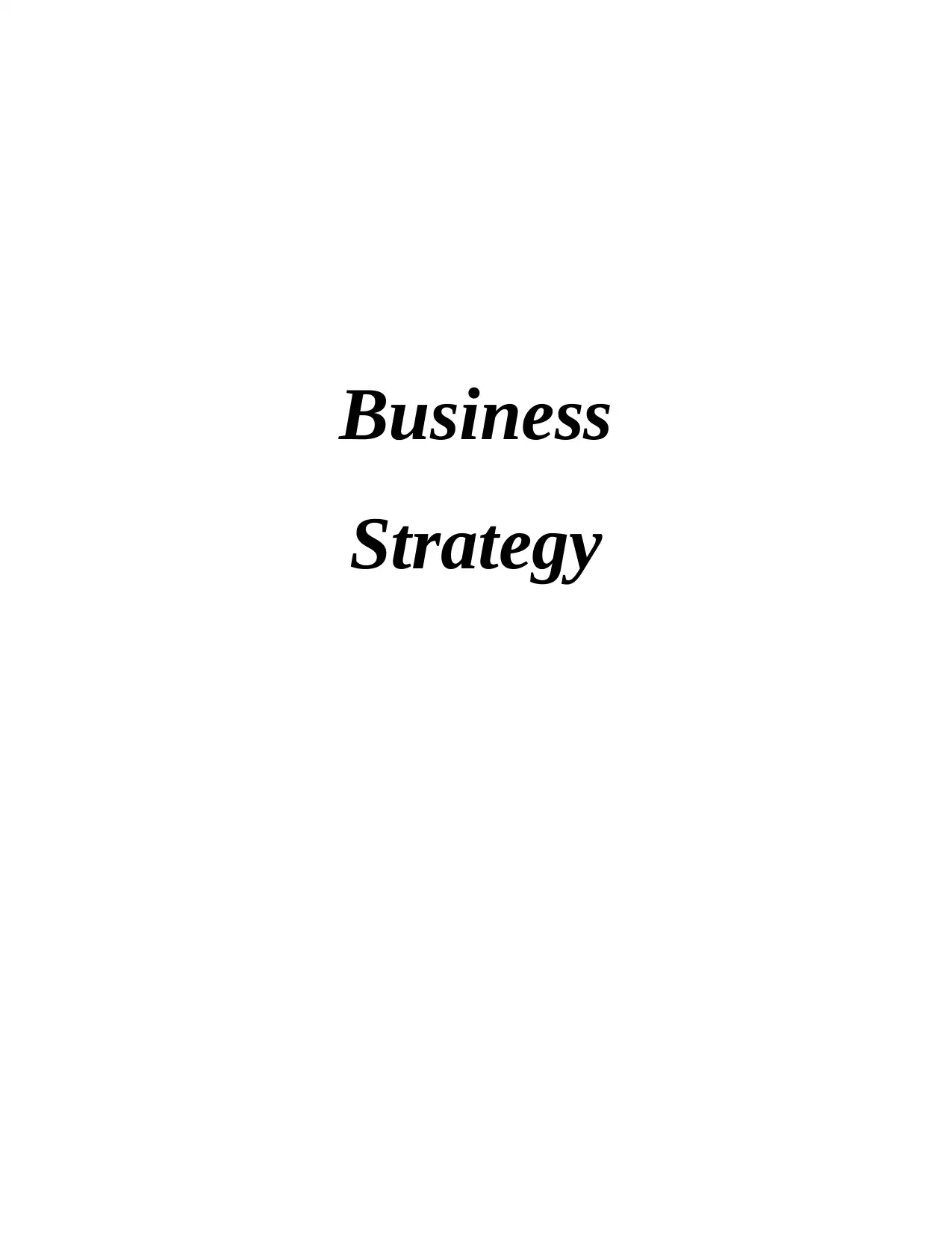
Business
Strategy
Strategy
Secure Best Marks with AI Grader
Need help grading? Try our AI Grader for instant feedback on your assignments.
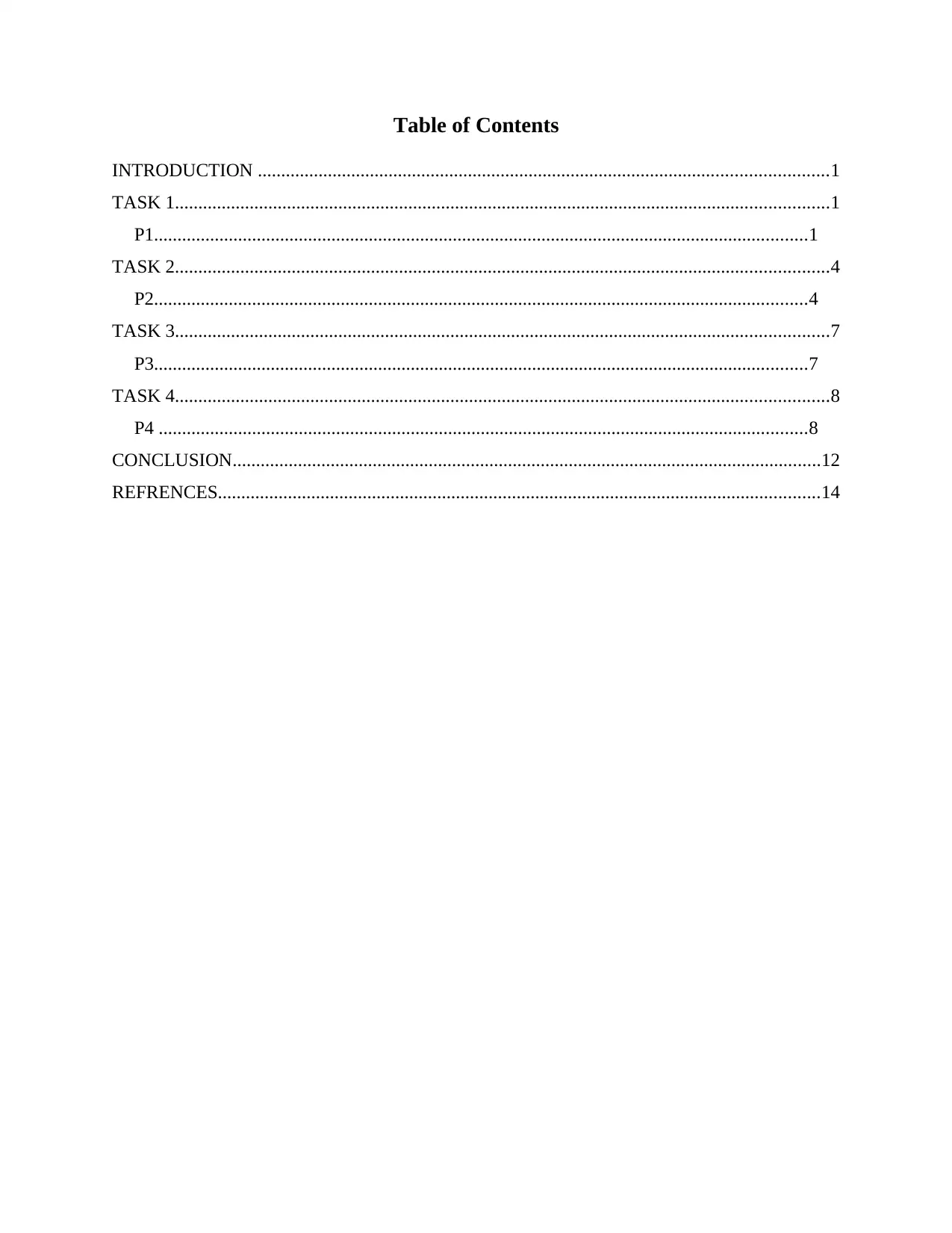
Table of Contents
INTRODUCTION ..........................................................................................................................1
TASK 1............................................................................................................................................1
P1............................................................................................................................................1
TASK 2............................................................................................................................................4
P2............................................................................................................................................4
TASK 3............................................................................................................................................7
P3............................................................................................................................................7
TASK 4............................................................................................................................................8
P4 ...........................................................................................................................................8
CONCLUSION..............................................................................................................................12
REFRENCES.................................................................................................................................14
INTRODUCTION ..........................................................................................................................1
TASK 1............................................................................................................................................1
P1............................................................................................................................................1
TASK 2............................................................................................................................................4
P2............................................................................................................................................4
TASK 3............................................................................................................................................7
P3............................................................................................................................................7
TASK 4............................................................................................................................................8
P4 ...........................................................................................................................................8
CONCLUSION..............................................................................................................................12
REFRENCES.................................................................................................................................14
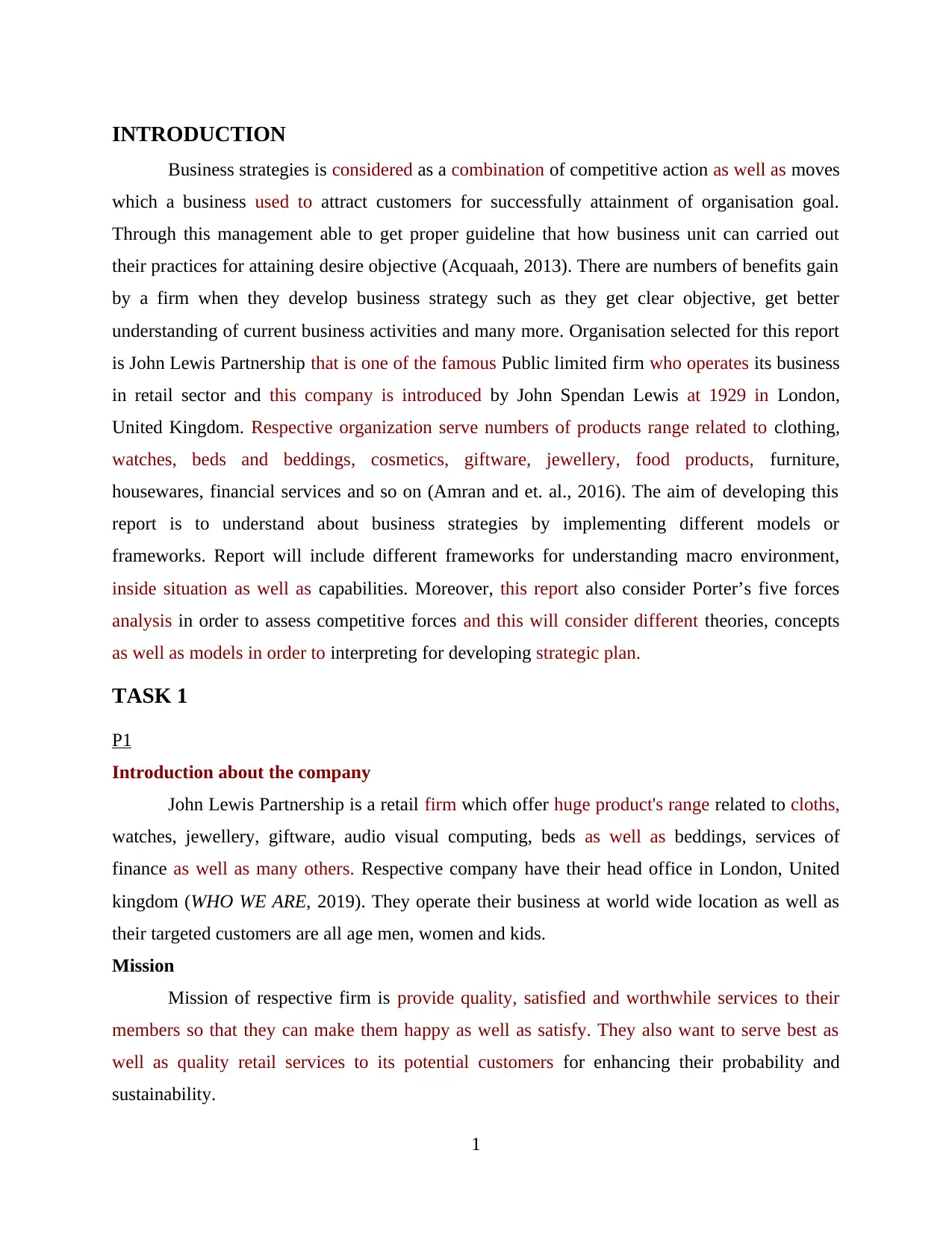
INTRODUCTION
Business strategies is considered as a combination of competitive action as well as moves
which a business used to attract customers for successfully attainment of organisation goal.
Through this management able to get proper guideline that how business unit can carried out
their practices for attaining desire objective (Acquaah, 2013). There are numbers of benefits gain
by a firm when they develop business strategy such as they get clear objective, get better
understanding of current business activities and many more. Organisation selected for this report
is John Lewis Partnership that is one of the famous Public limited firm who operates its business
in retail sector and this company is introduced by John Spendan Lewis at 1929 in London,
United Kingdom. Respective organization serve numbers of products range related to clothing,
watches, beds and beddings, cosmetics, giftware, jewellery, food products, furniture,
housewares, financial services and so on (Amran and et. al., 2016). The aim of developing this
report is to understand about business strategies by implementing different models or
frameworks. Report will include different frameworks for understanding macro environment,
inside situation as well as capabilities. Moreover, this report also consider Porter’s five forces
analysis in order to assess competitive forces and this will consider different theories, concepts
as well as models in order to interpreting for developing strategic plan.
TASK 1
P1
Introduction about the company
John Lewis Partnership is a retail firm which offer huge product's range related to cloths,
watches, jewellery, giftware, audio visual computing, beds as well as beddings, services of
finance as well as many others. Respective company have their head office in London, United
kingdom (WHO WE ARE, 2019). They operate their business at world wide location as well as
their targeted customers are all age men, women and kids.
Mission
Mission of respective firm is provide quality, satisfied and worthwhile services to their
members so that they can make them happy as well as satisfy. They also want to serve best as
well as quality retail services to its potential customers for enhancing their probability and
sustainability.
1
Business strategies is considered as a combination of competitive action as well as moves
which a business used to attract customers for successfully attainment of organisation goal.
Through this management able to get proper guideline that how business unit can carried out
their practices for attaining desire objective (Acquaah, 2013). There are numbers of benefits gain
by a firm when they develop business strategy such as they get clear objective, get better
understanding of current business activities and many more. Organisation selected for this report
is John Lewis Partnership that is one of the famous Public limited firm who operates its business
in retail sector and this company is introduced by John Spendan Lewis at 1929 in London,
United Kingdom. Respective organization serve numbers of products range related to clothing,
watches, beds and beddings, cosmetics, giftware, jewellery, food products, furniture,
housewares, financial services and so on (Amran and et. al., 2016). The aim of developing this
report is to understand about business strategies by implementing different models or
frameworks. Report will include different frameworks for understanding macro environment,
inside situation as well as capabilities. Moreover, this report also consider Porter’s five forces
analysis in order to assess competitive forces and this will consider different theories, concepts
as well as models in order to interpreting for developing strategic plan.
TASK 1
P1
Introduction about the company
John Lewis Partnership is a retail firm which offer huge product's range related to cloths,
watches, jewellery, giftware, audio visual computing, beds as well as beddings, services of
finance as well as many others. Respective company have their head office in London, United
kingdom (WHO WE ARE, 2019). They operate their business at world wide location as well as
their targeted customers are all age men, women and kids.
Mission
Mission of respective firm is provide quality, satisfied and worthwhile services to their
members so that they can make them happy as well as satisfy. They also want to serve best as
well as quality retail services to its potential customers for enhancing their probability and
sustainability.
1
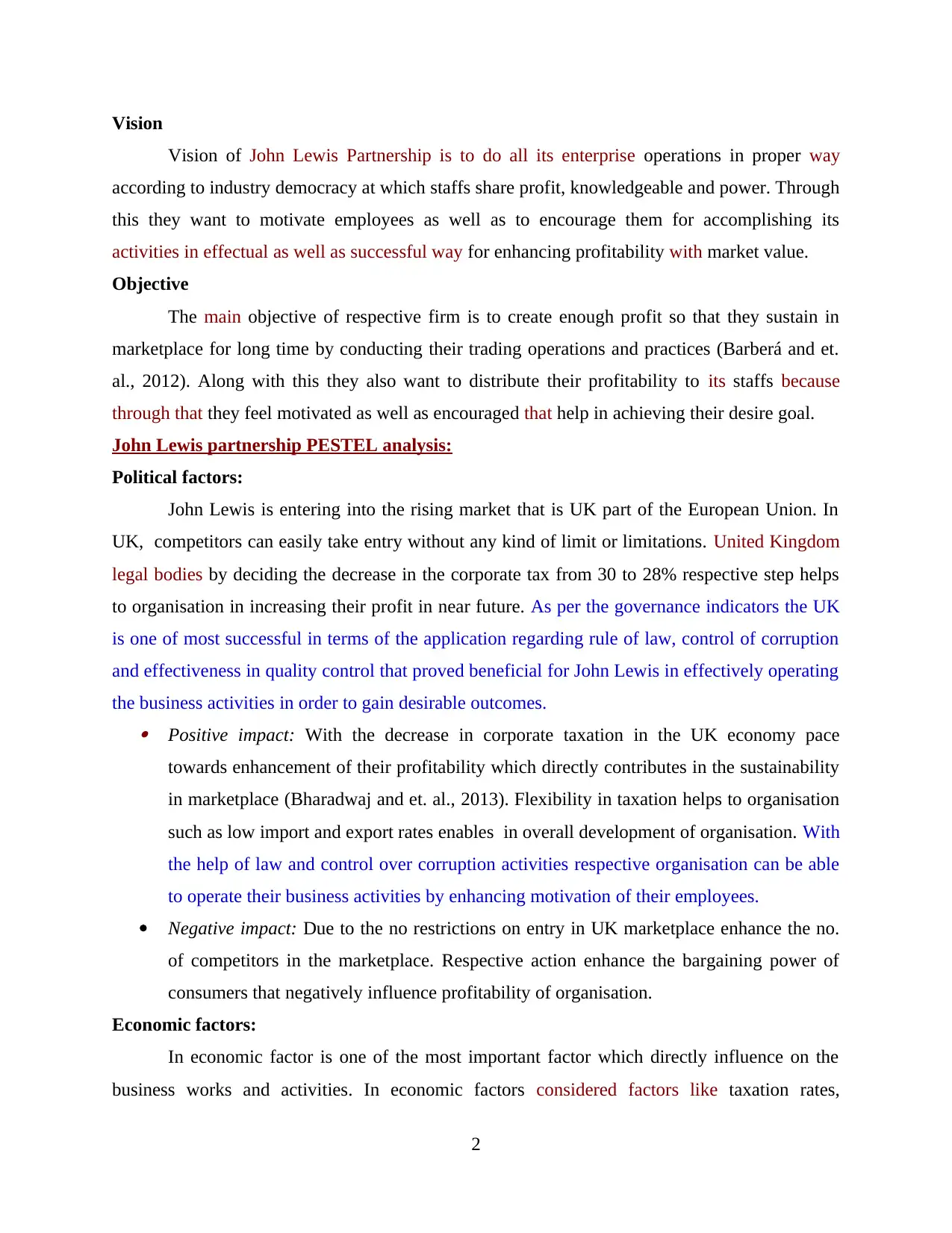
Vision
Vision of John Lewis Partnership is to do all its enterprise operations in proper way
according to industry democracy at which staffs share profit, knowledgeable and power. Through
this they want to motivate employees as well as to encourage them for accomplishing its
activities in effectual as well as successful way for enhancing profitability with market value.
Objective
The main objective of respective firm is to create enough profit so that they sustain in
marketplace for long time by conducting their trading operations and practices (Barberá and et.
al., 2012). Along with this they also want to distribute their profitability to its staffs because
through that they feel motivated as well as encouraged that help in achieving their desire goal.
John Lewis partnership PESTEL analysis:
Political factors:
John Lewis is entering into the rising market that is UK part of the European Union. In
UK, competitors can easily take entry without any kind of limit or limitations. United Kingdom
legal bodies by deciding the decrease in the corporate tax from 30 to 28% respective step helps
to organisation in increasing their profit in near future. As per the governance indicators the UK
is one of most successful in terms of the application regarding rule of law, control of corruption
and effectiveness in quality control that proved beneficial for John Lewis in effectively operating
the business activities in order to gain desirable outcomes. Positive impact: With the decrease in corporate taxation in the UK economy pace
towards enhancement of their profitability which directly contributes in the sustainability
in marketplace (Bharadwaj and et. al., 2013). Flexibility in taxation helps to organisation
such as low import and export rates enables in overall development of organisation. With
the help of law and control over corruption activities respective organisation can be able
to operate their business activities by enhancing motivation of their employees.
Negative impact: Due to the no restrictions on entry in UK marketplace enhance the no.
of competitors in the marketplace. Respective action enhance the bargaining power of
consumers that negatively influence profitability of organisation.
Economic factors:
In economic factor is one of the most important factor which directly influence on the
business works and activities. In economic factors considered factors like taxation rates,
2
Vision of John Lewis Partnership is to do all its enterprise operations in proper way
according to industry democracy at which staffs share profit, knowledgeable and power. Through
this they want to motivate employees as well as to encourage them for accomplishing its
activities in effectual as well as successful way for enhancing profitability with market value.
Objective
The main objective of respective firm is to create enough profit so that they sustain in
marketplace for long time by conducting their trading operations and practices (Barberá and et.
al., 2012). Along with this they also want to distribute their profitability to its staffs because
through that they feel motivated as well as encouraged that help in achieving their desire goal.
John Lewis partnership PESTEL analysis:
Political factors:
John Lewis is entering into the rising market that is UK part of the European Union. In
UK, competitors can easily take entry without any kind of limit or limitations. United Kingdom
legal bodies by deciding the decrease in the corporate tax from 30 to 28% respective step helps
to organisation in increasing their profit in near future. As per the governance indicators the UK
is one of most successful in terms of the application regarding rule of law, control of corruption
and effectiveness in quality control that proved beneficial for John Lewis in effectively operating
the business activities in order to gain desirable outcomes. Positive impact: With the decrease in corporate taxation in the UK economy pace
towards enhancement of their profitability which directly contributes in the sustainability
in marketplace (Bharadwaj and et. al., 2013). Flexibility in taxation helps to organisation
such as low import and export rates enables in overall development of organisation. With
the help of law and control over corruption activities respective organisation can be able
to operate their business activities by enhancing motivation of their employees.
Negative impact: Due to the no restrictions on entry in UK marketplace enhance the no.
of competitors in the marketplace. Respective action enhance the bargaining power of
consumers that negatively influence profitability of organisation.
Economic factors:
In economic factor is one of the most important factor which directly influence on the
business works and activities. In economic factors considered factors like taxation rates,
2
Secure Best Marks with AI Grader
Need help grading? Try our AI Grader for instant feedback on your assignments.
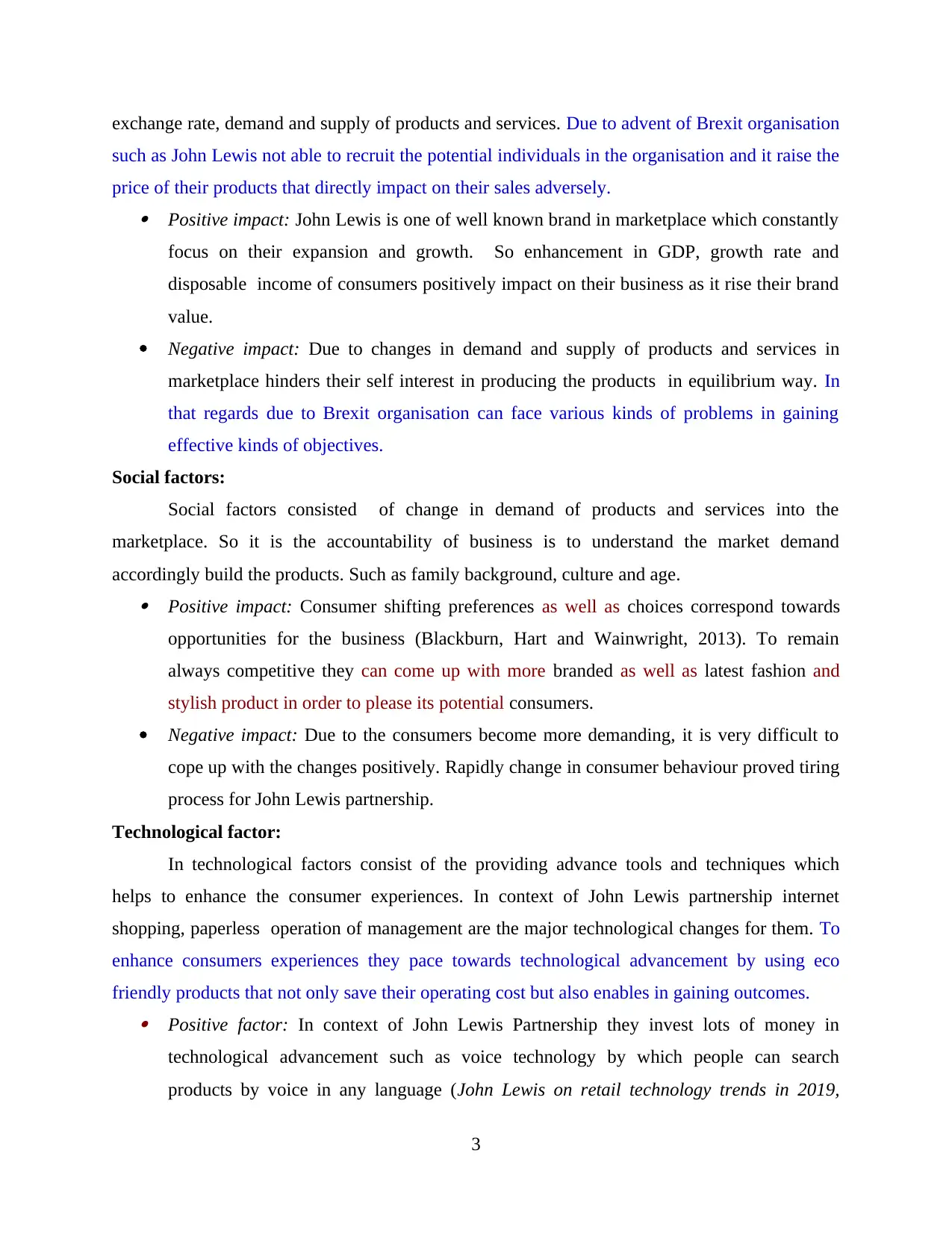
exchange rate, demand and supply of products and services. Due to advent of Brexit organisation
such as John Lewis not able to recruit the potential individuals in the organisation and it raise the
price of their products that directly impact on their sales adversely. Positive impact: John Lewis is one of well known brand in marketplace which constantly
focus on their expansion and growth. So enhancement in GDP, growth rate and
disposable income of consumers positively impact on their business as it rise their brand
value.
Negative impact: Due to changes in demand and supply of products and services in
marketplace hinders their self interest in producing the products in equilibrium way. In
that regards due to Brexit organisation can face various kinds of problems in gaining
effective kinds of objectives.
Social factors:
Social factors consisted of change in demand of products and services into the
marketplace. So it is the accountability of business is to understand the market demand
accordingly build the products. Such as family background, culture and age. Positive impact: Consumer shifting preferences as well as choices correspond towards
opportunities for the business (Blackburn, Hart and Wainwright, 2013). To remain
always competitive they can come up with more branded as well as latest fashion and
stylish product in order to please its potential consumers.
Negative impact: Due to the consumers become more demanding, it is very difficult to
cope up with the changes positively. Rapidly change in consumer behaviour proved tiring
process for John Lewis partnership.
Technological factor:
In technological factors consist of the providing advance tools and techniques which
helps to enhance the consumer experiences. In context of John Lewis partnership internet
shopping, paperless operation of management are the major technological changes for them. To
enhance consumers experiences they pace towards technological advancement by using eco
friendly products that not only save their operating cost but also enables in gaining outcomes. Positive factor: In context of John Lewis Partnership they invest lots of money in
technological advancement such as voice technology by which people can search
products by voice in any language (John Lewis on retail technology trends in 2019,
3
such as John Lewis not able to recruit the potential individuals in the organisation and it raise the
price of their products that directly impact on their sales adversely. Positive impact: John Lewis is one of well known brand in marketplace which constantly
focus on their expansion and growth. So enhancement in GDP, growth rate and
disposable income of consumers positively impact on their business as it rise their brand
value.
Negative impact: Due to changes in demand and supply of products and services in
marketplace hinders their self interest in producing the products in equilibrium way. In
that regards due to Brexit organisation can face various kinds of problems in gaining
effective kinds of objectives.
Social factors:
Social factors consisted of change in demand of products and services into the
marketplace. So it is the accountability of business is to understand the market demand
accordingly build the products. Such as family background, culture and age. Positive impact: Consumer shifting preferences as well as choices correspond towards
opportunities for the business (Blackburn, Hart and Wainwright, 2013). To remain
always competitive they can come up with more branded as well as latest fashion and
stylish product in order to please its potential consumers.
Negative impact: Due to the consumers become more demanding, it is very difficult to
cope up with the changes positively. Rapidly change in consumer behaviour proved tiring
process for John Lewis partnership.
Technological factor:
In technological factors consist of the providing advance tools and techniques which
helps to enhance the consumer experiences. In context of John Lewis partnership internet
shopping, paperless operation of management are the major technological changes for them. To
enhance consumers experiences they pace towards technological advancement by using eco
friendly products that not only save their operating cost but also enables in gaining outcomes. Positive factor: In context of John Lewis Partnership they invest lots of money in
technological advancement such as voice technology by which people can search
products by voice in any language (John Lewis on retail technology trends in 2019,
3
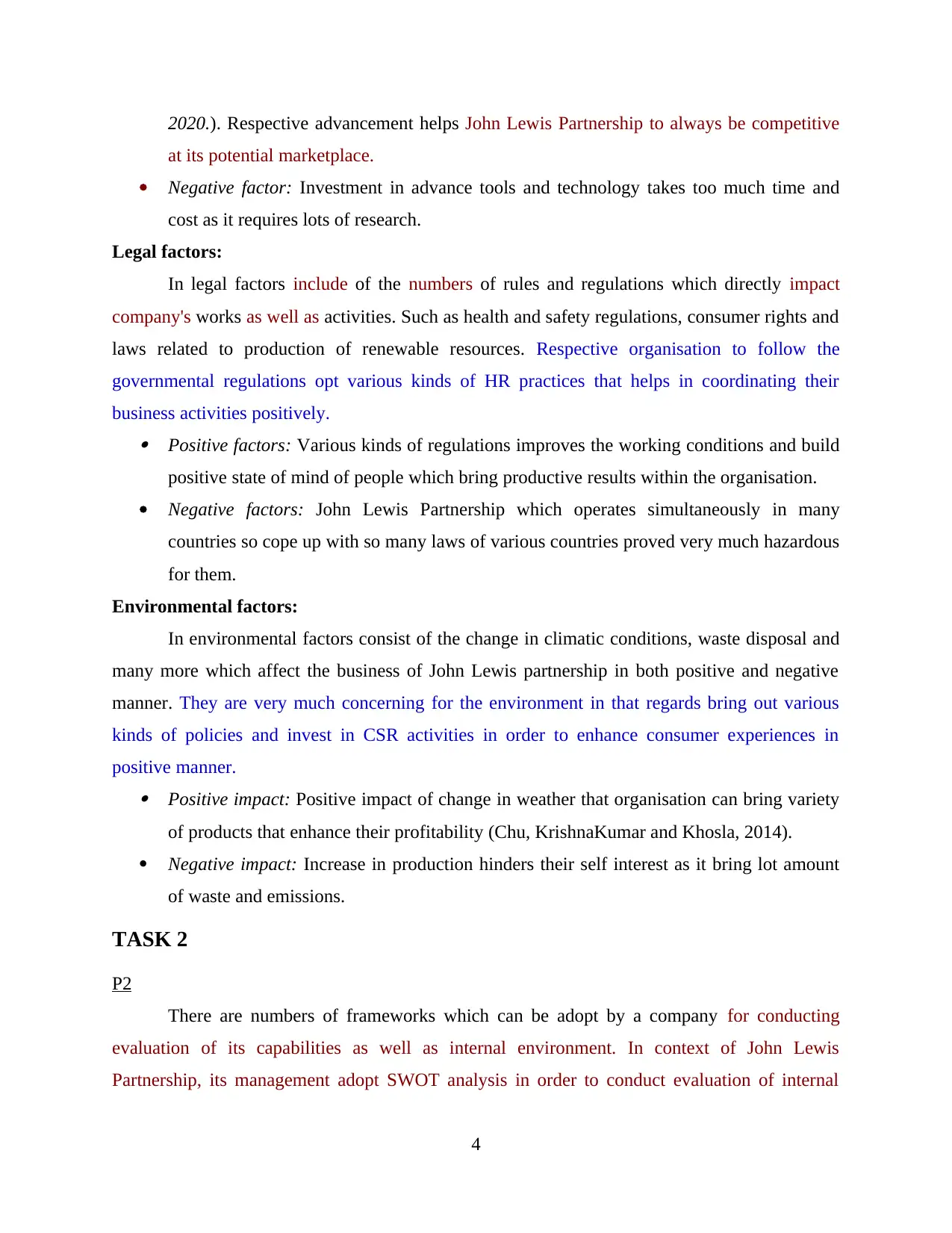
2020.). Respective advancement helps John Lewis Partnership to always be competitive
at its potential marketplace.
Negative factor: Investment in advance tools and technology takes too much time and
cost as it requires lots of research.
Legal factors:
In legal factors include of the numbers of rules and regulations which directly impact
company's works as well as activities. Such as health and safety regulations, consumer rights and
laws related to production of renewable resources. Respective organisation to follow the
governmental regulations opt various kinds of HR practices that helps in coordinating their
business activities positively. Positive factors: Various kinds of regulations improves the working conditions and build
positive state of mind of people which bring productive results within the organisation.
Negative factors: John Lewis Partnership which operates simultaneously in many
countries so cope up with so many laws of various countries proved very much hazardous
for them.
Environmental factors:
In environmental factors consist of the change in climatic conditions, waste disposal and
many more which affect the business of John Lewis partnership in both positive and negative
manner. They are very much concerning for the environment in that regards bring out various
kinds of policies and invest in CSR activities in order to enhance consumer experiences in
positive manner. Positive impact: Positive impact of change in weather that organisation can bring variety
of products that enhance their profitability (Chu, KrishnaKumar and Khosla, 2014).
Negative impact: Increase in production hinders their self interest as it bring lot amount
of waste and emissions.
TASK 2
P2
There are numbers of frameworks which can be adopt by a company for conducting
evaluation of its capabilities as well as internal environment. In context of John Lewis
Partnership, its management adopt SWOT analysis in order to conduct evaluation of internal
4
at its potential marketplace.
Negative factor: Investment in advance tools and technology takes too much time and
cost as it requires lots of research.
Legal factors:
In legal factors include of the numbers of rules and regulations which directly impact
company's works as well as activities. Such as health and safety regulations, consumer rights and
laws related to production of renewable resources. Respective organisation to follow the
governmental regulations opt various kinds of HR practices that helps in coordinating their
business activities positively. Positive factors: Various kinds of regulations improves the working conditions and build
positive state of mind of people which bring productive results within the organisation.
Negative factors: John Lewis Partnership which operates simultaneously in many
countries so cope up with so many laws of various countries proved very much hazardous
for them.
Environmental factors:
In environmental factors consist of the change in climatic conditions, waste disposal and
many more which affect the business of John Lewis partnership in both positive and negative
manner. They are very much concerning for the environment in that regards bring out various
kinds of policies and invest in CSR activities in order to enhance consumer experiences in
positive manner. Positive impact: Positive impact of change in weather that organisation can bring variety
of products that enhance their profitability (Chu, KrishnaKumar and Khosla, 2014).
Negative impact: Increase in production hinders their self interest as it bring lot amount
of waste and emissions.
TASK 2
P2
There are numbers of frameworks which can be adopt by a company for conducting
evaluation of its capabilities as well as internal environment. In context of John Lewis
Partnership, its management adopt SWOT analysis in order to conduct evaluation of internal
4
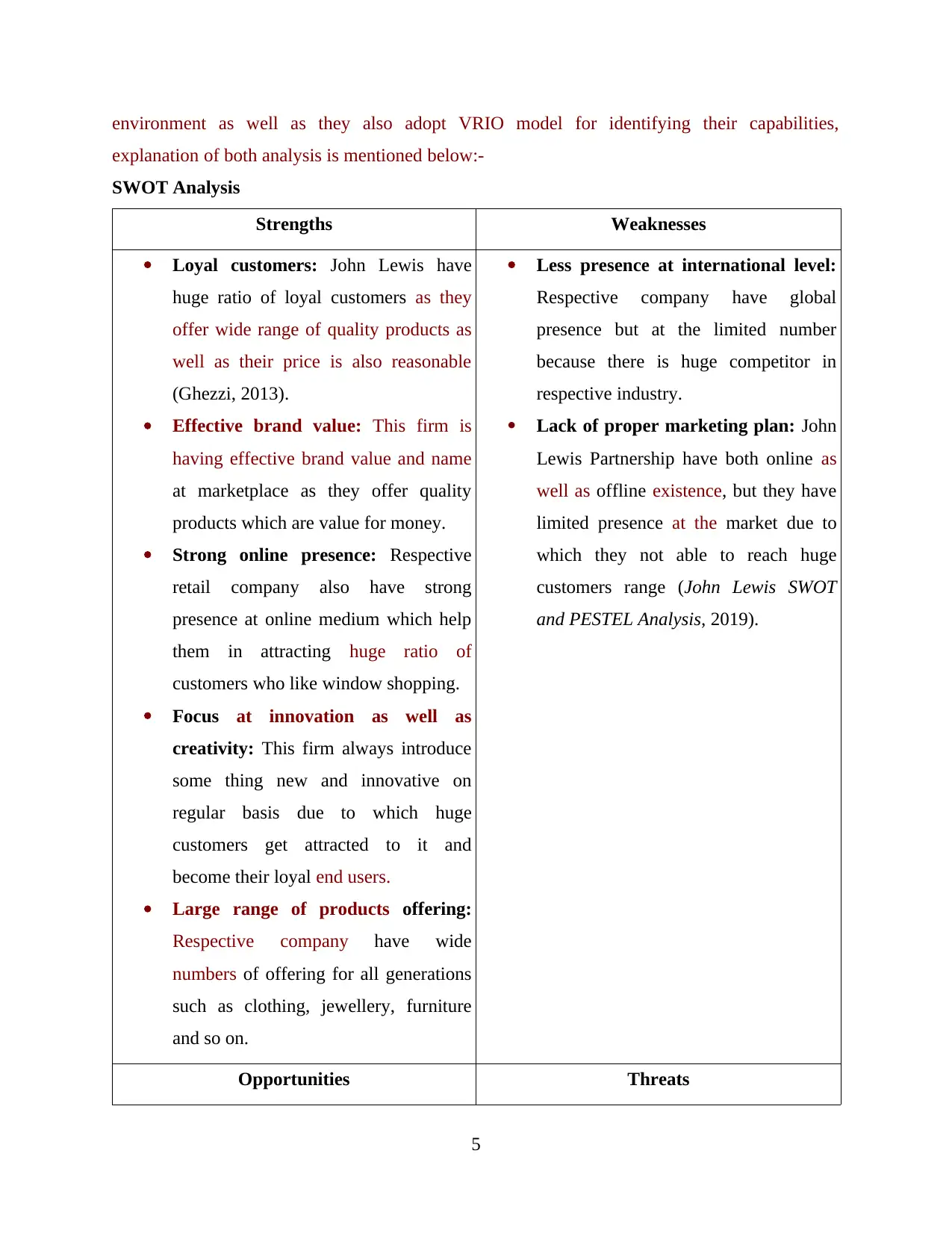
environment as well as they also adopt VRIO model for identifying their capabilities,
explanation of both analysis is mentioned below:-
SWOT Analysis
Strengths Weaknesses
Loyal customers: John Lewis have
huge ratio of loyal customers as they
offer wide range of quality products as
well as their price is also reasonable
(Ghezzi, 2013).
Effective brand value: This firm is
having effective brand value and name
at marketplace as they offer quality
products which are value for money.
Strong online presence: Respective
retail company also have strong
presence at online medium which help
them in attracting huge ratio of
customers who like window shopping.
Focus at innovation as well as
creativity: This firm always introduce
some thing new and innovative on
regular basis due to which huge
customers get attracted to it and
become their loyal end users.
Large range of products offering:
Respective company have wide
numbers of offering for all generations
such as clothing, jewellery, furniture
and so on.
Less presence at international level:
Respective company have global
presence but at the limited number
because there is huge competitor in
respective industry.
Lack of proper marketing plan: John
Lewis Partnership have both online as
well as offline existence, but they have
limited presence at the market due to
which they not able to reach huge
customers range (John Lewis SWOT
and PESTEL Analysis, 2019).
Opportunities Threats
5
explanation of both analysis is mentioned below:-
SWOT Analysis
Strengths Weaknesses
Loyal customers: John Lewis have
huge ratio of loyal customers as they
offer wide range of quality products as
well as their price is also reasonable
(Ghezzi, 2013).
Effective brand value: This firm is
having effective brand value and name
at marketplace as they offer quality
products which are value for money.
Strong online presence: Respective
retail company also have strong
presence at online medium which help
them in attracting huge ratio of
customers who like window shopping.
Focus at innovation as well as
creativity: This firm always introduce
some thing new and innovative on
regular basis due to which huge
customers get attracted to it and
become their loyal end users.
Large range of products offering:
Respective company have wide
numbers of offering for all generations
such as clothing, jewellery, furniture
and so on.
Less presence at international level:
Respective company have global
presence but at the limited number
because there is huge competitor in
respective industry.
Lack of proper marketing plan: John
Lewis Partnership have both online as
well as offline existence, but they have
limited presence at the market due to
which they not able to reach huge
customers range (John Lewis SWOT
and PESTEL Analysis, 2019).
Opportunities Threats
5
Paraphrase This Document
Need a fresh take? Get an instant paraphrase of this document with our AI Paraphraser
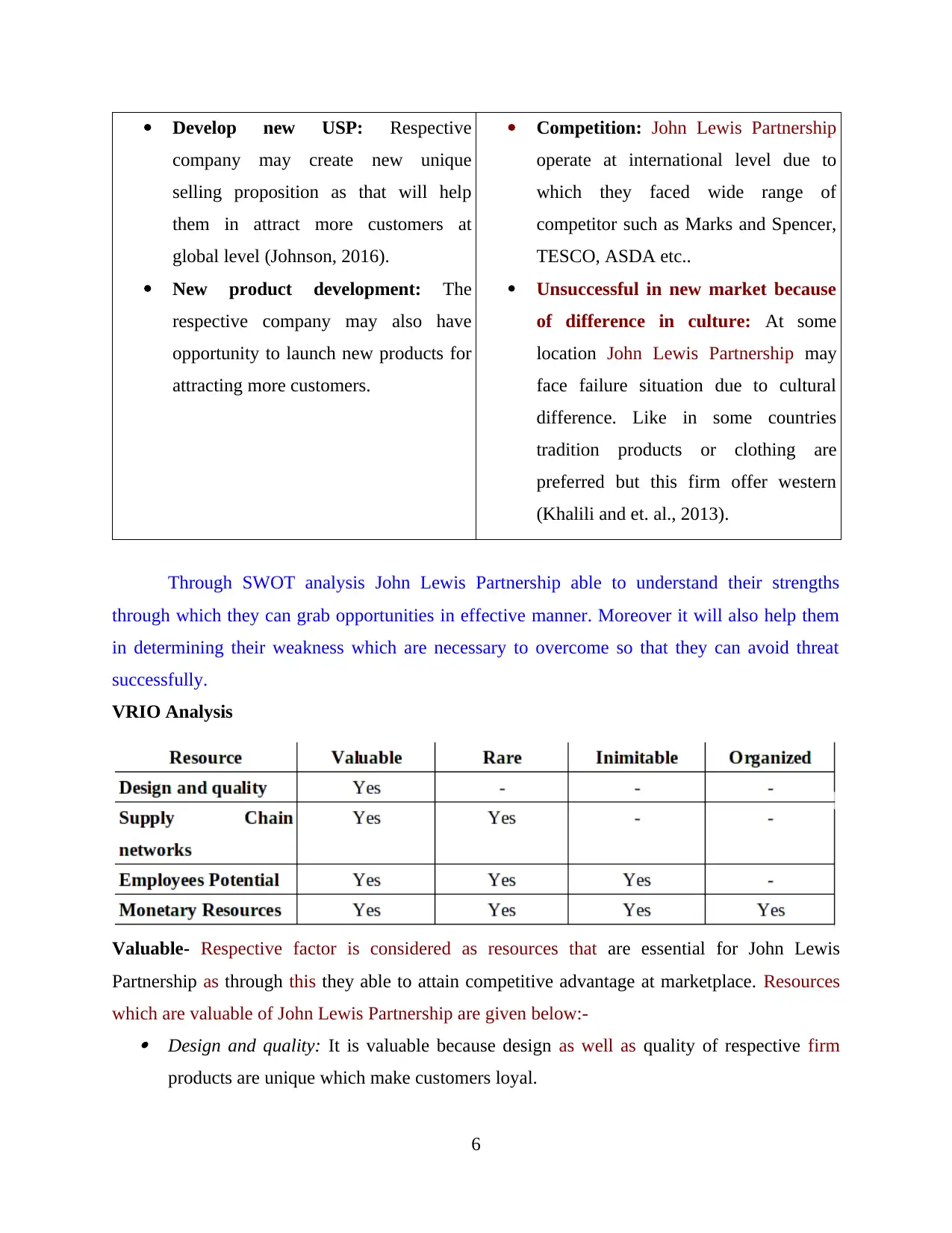
Develop new USP: Respective
company may create new unique
selling proposition as that will help
them in attract more customers at
global level (Johnson, 2016).
New product development: The
respective company may also have
opportunity to launch new products for
attracting more customers.
Competition: John Lewis Partnership
operate at international level due to
which they faced wide range of
competitor such as Marks and Spencer,
TESCO, ASDA etc..
Unsuccessful in new market because
of difference in culture: At some
location John Lewis Partnership may
face failure situation due to cultural
difference. Like in some countries
tradition products or clothing are
preferred but this firm offer western
(Khalili and et. al., 2013).
Through SWOT analysis John Lewis Partnership able to understand their strengths
through which they can grab opportunities in effective manner. Moreover it will also help them
in determining their weakness which are necessary to overcome so that they can avoid threat
successfully.
VRIO Analysis
Valuable- Respective factor is considered as resources that are essential for John Lewis
Partnership as through this they able to attain competitive advantage at marketplace. Resources
which are valuable of John Lewis Partnership are given below:- Design and quality: It is valuable because design as well as quality of respective firm
products are unique which make customers loyal.
6
company may create new unique
selling proposition as that will help
them in attract more customers at
global level (Johnson, 2016).
New product development: The
respective company may also have
opportunity to launch new products for
attracting more customers.
Competition: John Lewis Partnership
operate at international level due to
which they faced wide range of
competitor such as Marks and Spencer,
TESCO, ASDA etc..
Unsuccessful in new market because
of difference in culture: At some
location John Lewis Partnership may
face failure situation due to cultural
difference. Like in some countries
tradition products or clothing are
preferred but this firm offer western
(Khalili and et. al., 2013).
Through SWOT analysis John Lewis Partnership able to understand their strengths
through which they can grab opportunities in effective manner. Moreover it will also help them
in determining their weakness which are necessary to overcome so that they can avoid threat
successfully.
VRIO Analysis
Valuable- Respective factor is considered as resources that are essential for John Lewis
Partnership as through this they able to attain competitive advantage at marketplace. Resources
which are valuable of John Lewis Partnership are given below:- Design and quality: It is valuable because design as well as quality of respective firm
products are unique which make customers loyal.
6
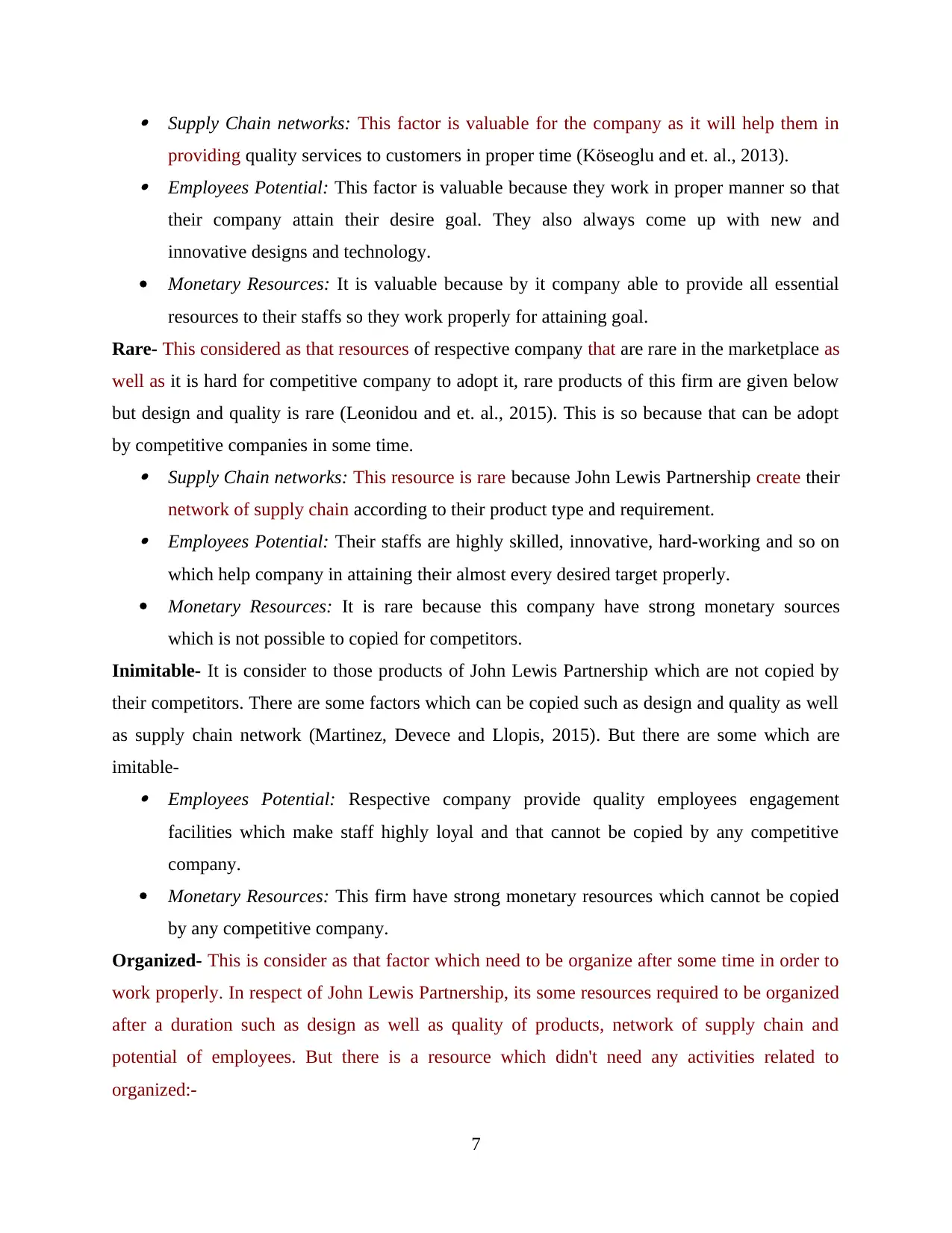
Supply Chain networks: This factor is valuable for the company as it will help them in
providing quality services to customers in proper time (Köseoglu and et. al., 2013). Employees Potential: This factor is valuable because they work in proper manner so that
their company attain their desire goal. They also always come up with new and
innovative designs and technology.
Monetary Resources: It is valuable because by it company able to provide all essential
resources to their staffs so they work properly for attaining goal.
Rare- This considered as that resources of respective company that are rare in the marketplace as
well as it is hard for competitive company to adopt it, rare products of this firm are given below
but design and quality is rare (Leonidou and et. al., 2015). This is so because that can be adopt
by competitive companies in some time. Supply Chain networks: This resource is rare because John Lewis Partnership create their
network of supply chain according to their product type and requirement. Employees Potential: Their staffs are highly skilled, innovative, hard-working and so on
which help company in attaining their almost every desired target properly.
Monetary Resources: It is rare because this company have strong monetary sources
which is not possible to copied for competitors.
Inimitable- It is consider to those products of John Lewis Partnership which are not copied by
their competitors. There are some factors which can be copied such as design and quality as well
as supply chain network (Martinez, Devece and Llopis, 2015). But there are some which are
imitable- Employees Potential: Respective company provide quality employees engagement
facilities which make staff highly loyal and that cannot be copied by any competitive
company.
Monetary Resources: This firm have strong monetary resources which cannot be copied
by any competitive company.
Organized- This is consider as that factor which need to be organize after some time in order to
work properly. In respect of John Lewis Partnership, its some resources required to be organized
after a duration such as design as well as quality of products, network of supply chain and
potential of employees. But there is a resource which didn't need any activities related to
organized:-
7
providing quality services to customers in proper time (Köseoglu and et. al., 2013). Employees Potential: This factor is valuable because they work in proper manner so that
their company attain their desire goal. They also always come up with new and
innovative designs and technology.
Monetary Resources: It is valuable because by it company able to provide all essential
resources to their staffs so they work properly for attaining goal.
Rare- This considered as that resources of respective company that are rare in the marketplace as
well as it is hard for competitive company to adopt it, rare products of this firm are given below
but design and quality is rare (Leonidou and et. al., 2015). This is so because that can be adopt
by competitive companies in some time. Supply Chain networks: This resource is rare because John Lewis Partnership create their
network of supply chain according to their product type and requirement. Employees Potential: Their staffs are highly skilled, innovative, hard-working and so on
which help company in attaining their almost every desired target properly.
Monetary Resources: It is rare because this company have strong monetary sources
which is not possible to copied for competitors.
Inimitable- It is consider to those products of John Lewis Partnership which are not copied by
their competitors. There are some factors which can be copied such as design and quality as well
as supply chain network (Martinez, Devece and Llopis, 2015). But there are some which are
imitable- Employees Potential: Respective company provide quality employees engagement
facilities which make staff highly loyal and that cannot be copied by any competitive
company.
Monetary Resources: This firm have strong monetary resources which cannot be copied
by any competitive company.
Organized- This is consider as that factor which need to be organize after some time in order to
work properly. In respect of John Lewis Partnership, its some resources required to be organized
after a duration such as design as well as quality of products, network of supply chain and
potential of employees. But there is a resource which didn't need any activities related to
organized:-
7
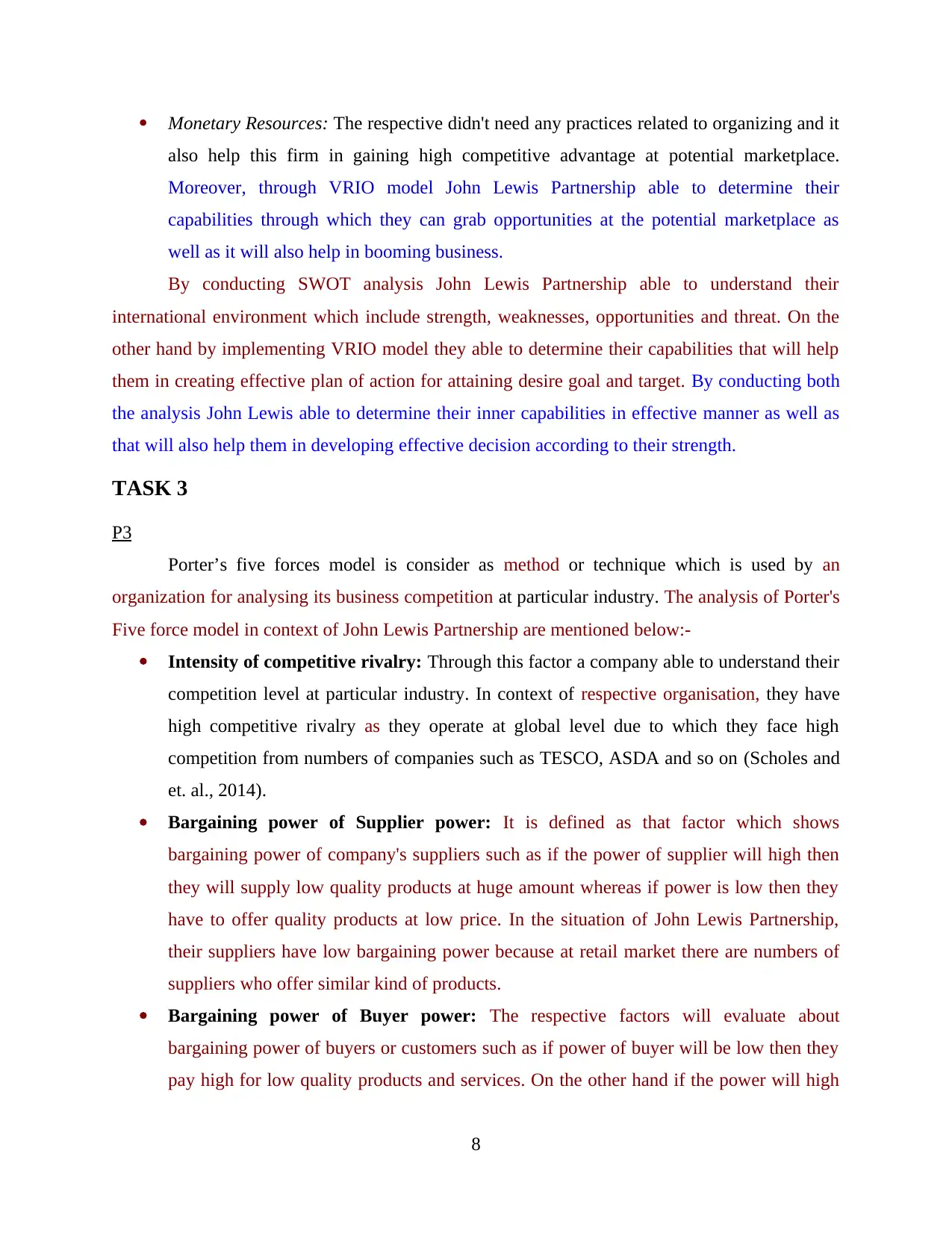
Monetary Resources: The respective didn't need any practices related to organizing and it
also help this firm in gaining high competitive advantage at potential marketplace.
Moreover, through VRIO model John Lewis Partnership able to determine their
capabilities through which they can grab opportunities at the potential marketplace as
well as it will also help in booming business.
By conducting SWOT analysis John Lewis Partnership able to understand their
international environment which include strength, weaknesses, opportunities and threat. On the
other hand by implementing VRIO model they able to determine their capabilities that will help
them in creating effective plan of action for attaining desire goal and target. By conducting both
the analysis John Lewis able to determine their inner capabilities in effective manner as well as
that will also help them in developing effective decision according to their strength.
TASK 3
P3
Porter’s five forces model is consider as method or technique which is used by an
organization for analysing its business competition at particular industry. The analysis of Porter's
Five force model in context of John Lewis Partnership are mentioned below:-
Intensity of competitive rivalry: Through this factor a company able to understand their
competition level at particular industry. In context of respective organisation, they have
high competitive rivalry as they operate at global level due to which they face high
competition from numbers of companies such as TESCO, ASDA and so on (Scholes and
et. al., 2014).
Bargaining power of Supplier power: It is defined as that factor which shows
bargaining power of company's suppliers such as if the power of supplier will high then
they will supply low quality products at huge amount whereas if power is low then they
have to offer quality products at low price. In the situation of John Lewis Partnership,
their suppliers have low bargaining power because at retail market there are numbers of
suppliers who offer similar kind of products.
Bargaining power of Buyer power: The respective factors will evaluate about
bargaining power of buyers or customers such as if power of buyer will be low then they
pay high for low quality products and services. On the other hand if the power will high
8
also help this firm in gaining high competitive advantage at potential marketplace.
Moreover, through VRIO model John Lewis Partnership able to determine their
capabilities through which they can grab opportunities at the potential marketplace as
well as it will also help in booming business.
By conducting SWOT analysis John Lewis Partnership able to understand their
international environment which include strength, weaknesses, opportunities and threat. On the
other hand by implementing VRIO model they able to determine their capabilities that will help
them in creating effective plan of action for attaining desire goal and target. By conducting both
the analysis John Lewis able to determine their inner capabilities in effective manner as well as
that will also help them in developing effective decision according to their strength.
TASK 3
P3
Porter’s five forces model is consider as method or technique which is used by an
organization for analysing its business competition at particular industry. The analysis of Porter's
Five force model in context of John Lewis Partnership are mentioned below:-
Intensity of competitive rivalry: Through this factor a company able to understand their
competition level at particular industry. In context of respective organisation, they have
high competitive rivalry as they operate at global level due to which they face high
competition from numbers of companies such as TESCO, ASDA and so on (Scholes and
et. al., 2014).
Bargaining power of Supplier power: It is defined as that factor which shows
bargaining power of company's suppliers such as if the power of supplier will high then
they will supply low quality products at huge amount whereas if power is low then they
have to offer quality products at low price. In the situation of John Lewis Partnership,
their suppliers have low bargaining power because at retail market there are numbers of
suppliers who offer similar kind of products.
Bargaining power of Buyer power: The respective factors will evaluate about
bargaining power of buyers or customers such as if power of buyer will be low then they
pay high for low quality products and services. On the other hand if the power will high
8
Secure Best Marks with AI Grader
Need help grading? Try our AI Grader for instant feedback on your assignments.
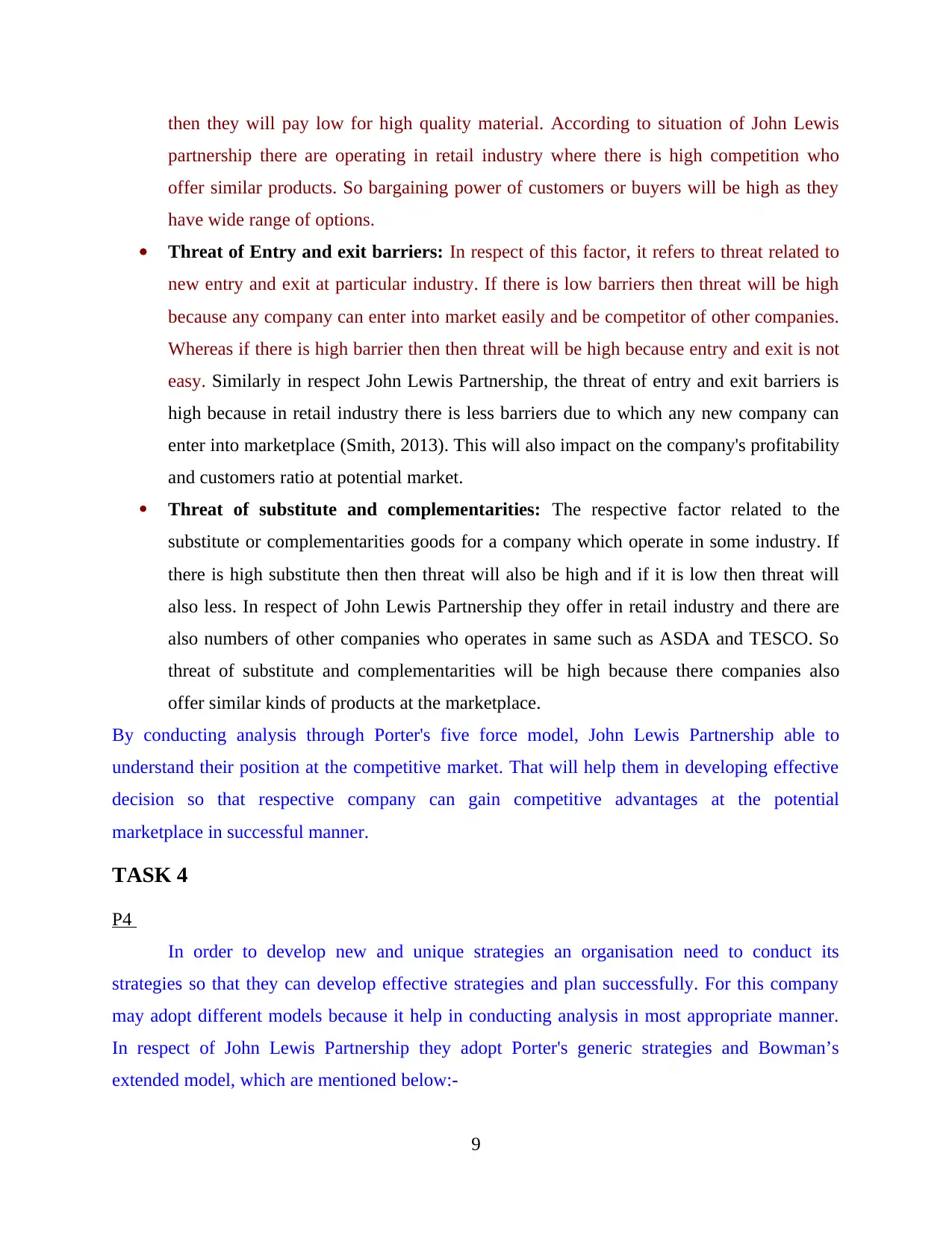
then they will pay low for high quality material. According to situation of John Lewis
partnership there are operating in retail industry where there is high competition who
offer similar products. So bargaining power of customers or buyers will be high as they
have wide range of options.
Threat of Entry and exit barriers: In respect of this factor, it refers to threat related to
new entry and exit at particular industry. If there is low barriers then threat will be high
because any company can enter into market easily and be competitor of other companies.
Whereas if there is high barrier then then threat will be high because entry and exit is not
easy. Similarly in respect John Lewis Partnership, the threat of entry and exit barriers is
high because in retail industry there is less barriers due to which any new company can
enter into marketplace (Smith, 2013). This will also impact on the company's profitability
and customers ratio at potential market.
Threat of substitute and complementarities: The respective factor related to the
substitute or complementarities goods for a company which operate in some industry. If
there is high substitute then then threat will also be high and if it is low then threat will
also less. In respect of John Lewis Partnership they offer in retail industry and there are
also numbers of other companies who operates in same such as ASDA and TESCO. So
threat of substitute and complementarities will be high because there companies also
offer similar kinds of products at the marketplace.
By conducting analysis through Porter's five force model, John Lewis Partnership able to
understand their position at the competitive market. That will help them in developing effective
decision so that respective company can gain competitive advantages at the potential
marketplace in successful manner.
TASK 4
P4
In order to develop new and unique strategies an organisation need to conduct its
strategies so that they can develop effective strategies and plan successfully. For this company
may adopt different models because it help in conducting analysis in most appropriate manner.
In respect of John Lewis Partnership they adopt Porter's generic strategies and Bowman’s
extended model, which are mentioned below:-
9
partnership there are operating in retail industry where there is high competition who
offer similar products. So bargaining power of customers or buyers will be high as they
have wide range of options.
Threat of Entry and exit barriers: In respect of this factor, it refers to threat related to
new entry and exit at particular industry. If there is low barriers then threat will be high
because any company can enter into market easily and be competitor of other companies.
Whereas if there is high barrier then then threat will be high because entry and exit is not
easy. Similarly in respect John Lewis Partnership, the threat of entry and exit barriers is
high because in retail industry there is less barriers due to which any new company can
enter into marketplace (Smith, 2013). This will also impact on the company's profitability
and customers ratio at potential market.
Threat of substitute and complementarities: The respective factor related to the
substitute or complementarities goods for a company which operate in some industry. If
there is high substitute then then threat will also be high and if it is low then threat will
also less. In respect of John Lewis Partnership they offer in retail industry and there are
also numbers of other companies who operates in same such as ASDA and TESCO. So
threat of substitute and complementarities will be high because there companies also
offer similar kinds of products at the marketplace.
By conducting analysis through Porter's five force model, John Lewis Partnership able to
understand their position at the competitive market. That will help them in developing effective
decision so that respective company can gain competitive advantages at the potential
marketplace in successful manner.
TASK 4
P4
In order to develop new and unique strategies an organisation need to conduct its
strategies so that they can develop effective strategies and plan successfully. For this company
may adopt different models because it help in conducting analysis in most appropriate manner.
In respect of John Lewis Partnership they adopt Porter's generic strategies and Bowman’s
extended model, which are mentioned below:-
9
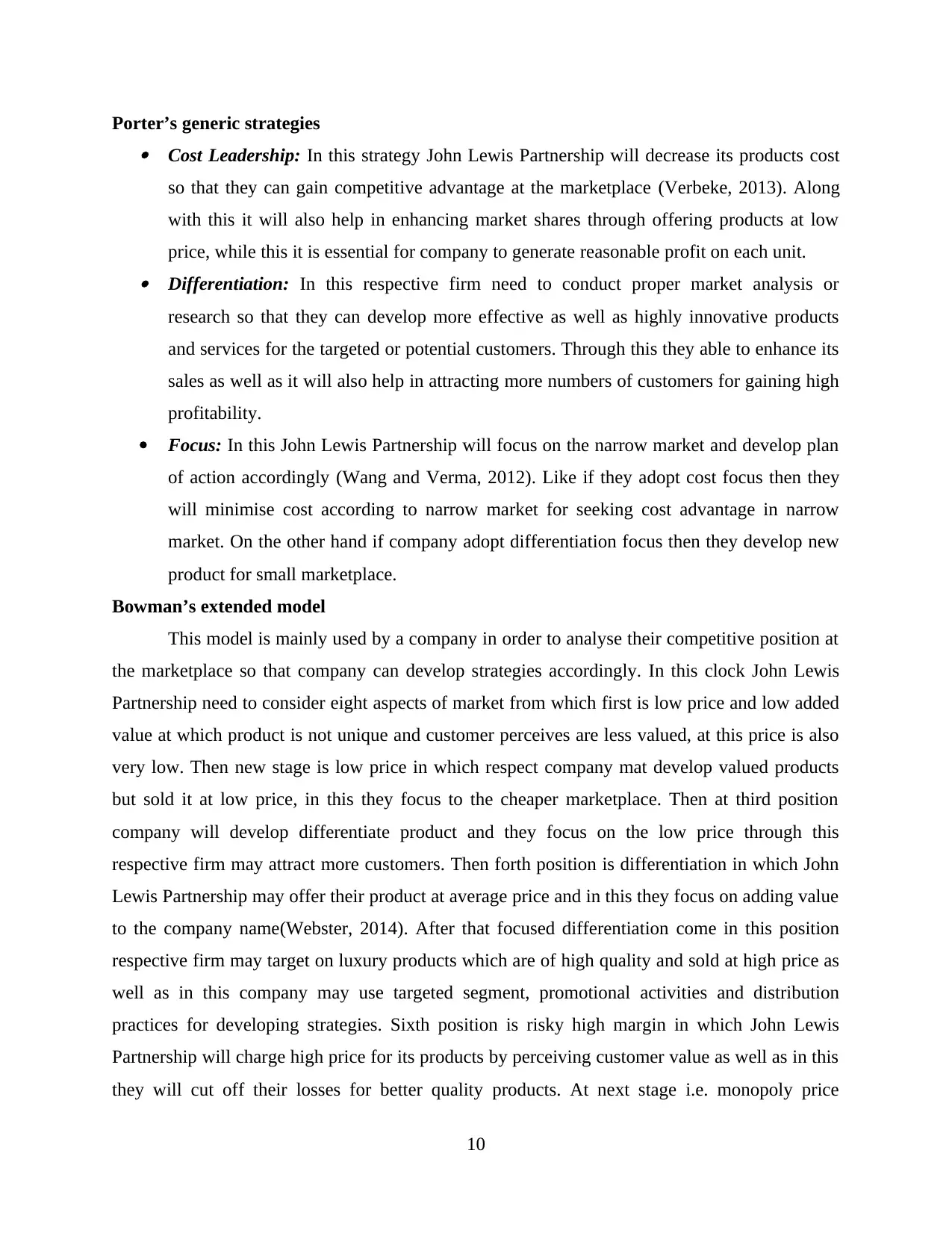
Porter’s generic strategies Cost Leadership: In this strategy John Lewis Partnership will decrease its products cost
so that they can gain competitive advantage at the marketplace (Verbeke, 2013). Along
with this it will also help in enhancing market shares through offering products at low
price, while this it is essential for company to generate reasonable profit on each unit. Differentiation: In this respective firm need to conduct proper market analysis or
research so that they can develop more effective as well as highly innovative products
and services for the targeted or potential customers. Through this they able to enhance its
sales as well as it will also help in attracting more numbers of customers for gaining high
profitability.
Focus: In this John Lewis Partnership will focus on the narrow market and develop plan
of action accordingly (Wang and Verma, 2012). Like if they adopt cost focus then they
will minimise cost according to narrow market for seeking cost advantage in narrow
market. On the other hand if company adopt differentiation focus then they develop new
product for small marketplace.
Bowman’s extended model
This model is mainly used by a company in order to analyse their competitive position at
the marketplace so that company can develop strategies accordingly. In this clock John Lewis
Partnership need to consider eight aspects of market from which first is low price and low added
value at which product is not unique and customer perceives are less valued, at this price is also
very low. Then new stage is low price in which respect company mat develop valued products
but sold it at low price, in this they focus to the cheaper marketplace. Then at third position
company will develop differentiate product and they focus on the low price through this
respective firm may attract more customers. Then forth position is differentiation in which John
Lewis Partnership may offer their product at average price and in this they focus on adding value
to the company name(Webster, 2014). After that focused differentiation come in this position
respective firm may target on luxury products which are of high quality and sold at high price as
well as in this company may use targeted segment, promotional activities and distribution
practices for developing strategies. Sixth position is risky high margin in which John Lewis
Partnership will charge high price for its products by perceiving customer value as well as in this
they will cut off their losses for better quality products. At next stage i.e. monopoly price
10
so that they can gain competitive advantage at the marketplace (Verbeke, 2013). Along
with this it will also help in enhancing market shares through offering products at low
price, while this it is essential for company to generate reasonable profit on each unit. Differentiation: In this respective firm need to conduct proper market analysis or
research so that they can develop more effective as well as highly innovative products
and services for the targeted or potential customers. Through this they able to enhance its
sales as well as it will also help in attracting more numbers of customers for gaining high
profitability.
Focus: In this John Lewis Partnership will focus on the narrow market and develop plan
of action accordingly (Wang and Verma, 2012). Like if they adopt cost focus then they
will minimise cost according to narrow market for seeking cost advantage in narrow
market. On the other hand if company adopt differentiation focus then they develop new
product for small marketplace.
Bowman’s extended model
This model is mainly used by a company in order to analyse their competitive position at
the marketplace so that company can develop strategies accordingly. In this clock John Lewis
Partnership need to consider eight aspects of market from which first is low price and low added
value at which product is not unique and customer perceives are less valued, at this price is also
very low. Then new stage is low price in which respect company mat develop valued products
but sold it at low price, in this they focus to the cheaper marketplace. Then at third position
company will develop differentiate product and they focus on the low price through this
respective firm may attract more customers. Then forth position is differentiation in which John
Lewis Partnership may offer their product at average price and in this they focus on adding value
to the company name(Webster, 2014). After that focused differentiation come in this position
respective firm may target on luxury products which are of high quality and sold at high price as
well as in this company may use targeted segment, promotional activities and distribution
practices for developing strategies. Sixth position is risky high margin in which John Lewis
Partnership will charge high price for its products by perceiving customer value as well as in this
they will cut off their losses for better quality products. At next stage i.e. monopoly price
10
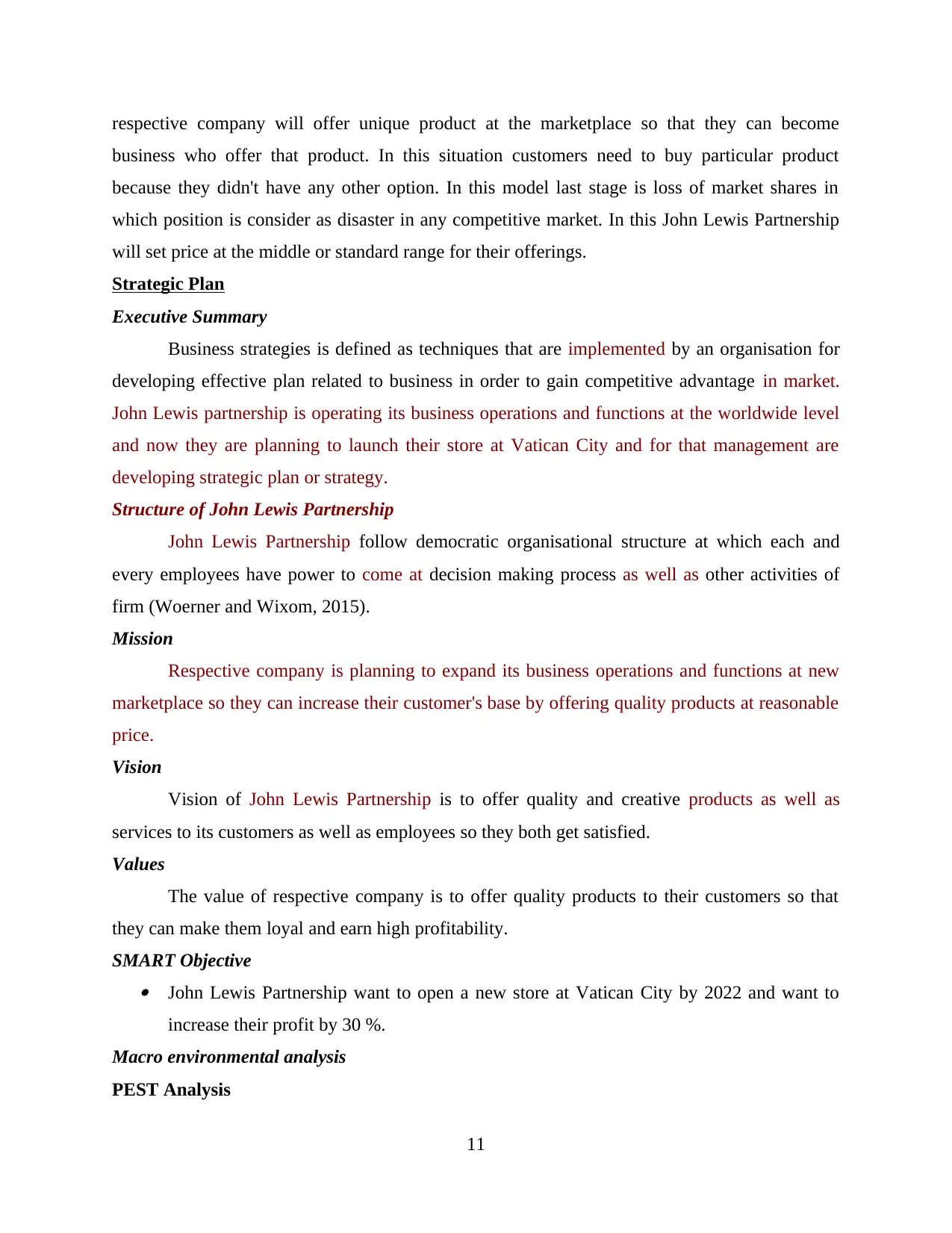
respective company will offer unique product at the marketplace so that they can become
business who offer that product. In this situation customers need to buy particular product
because they didn't have any other option. In this model last stage is loss of market shares in
which position is consider as disaster in any competitive market. In this John Lewis Partnership
will set price at the middle or standard range for their offerings.
Strategic Plan
Executive Summary
Business strategies is defined as techniques that are implemented by an organisation for
developing effective plan related to business in order to gain competitive advantage in market.
John Lewis partnership is operating its business operations and functions at the worldwide level
and now they are planning to launch their store at Vatican City and for that management are
developing strategic plan or strategy.
Structure of John Lewis Partnership
John Lewis Partnership follow democratic organisational structure at which each and
every employees have power to come at decision making process as well as other activities of
firm (Woerner and Wixom, 2015).
Mission
Respective company is planning to expand its business operations and functions at new
marketplace so they can increase their customer's base by offering quality products at reasonable
price.
Vision
Vision of John Lewis Partnership is to offer quality and creative products as well as
services to its customers as well as employees so they both get satisfied.
Values
The value of respective company is to offer quality products to their customers so that
they can make them loyal and earn high profitability.
SMART Objective John Lewis Partnership want to open a new store at Vatican City by 2022 and want to
increase their profit by 30 %.
Macro environmental analysis
PEST Analysis
11
business who offer that product. In this situation customers need to buy particular product
because they didn't have any other option. In this model last stage is loss of market shares in
which position is consider as disaster in any competitive market. In this John Lewis Partnership
will set price at the middle or standard range for their offerings.
Strategic Plan
Executive Summary
Business strategies is defined as techniques that are implemented by an organisation for
developing effective plan related to business in order to gain competitive advantage in market.
John Lewis partnership is operating its business operations and functions at the worldwide level
and now they are planning to launch their store at Vatican City and for that management are
developing strategic plan or strategy.
Structure of John Lewis Partnership
John Lewis Partnership follow democratic organisational structure at which each and
every employees have power to come at decision making process as well as other activities of
firm (Woerner and Wixom, 2015).
Mission
Respective company is planning to expand its business operations and functions at new
marketplace so they can increase their customer's base by offering quality products at reasonable
price.
Vision
Vision of John Lewis Partnership is to offer quality and creative products as well as
services to its customers as well as employees so they both get satisfied.
Values
The value of respective company is to offer quality products to their customers so that
they can make them loyal and earn high profitability.
SMART Objective John Lewis Partnership want to open a new store at Vatican City by 2022 and want to
increase their profit by 30 %.
Macro environmental analysis
PEST Analysis
11
Paraphrase This Document
Need a fresh take? Get an instant paraphrase of this document with our AI Paraphraser
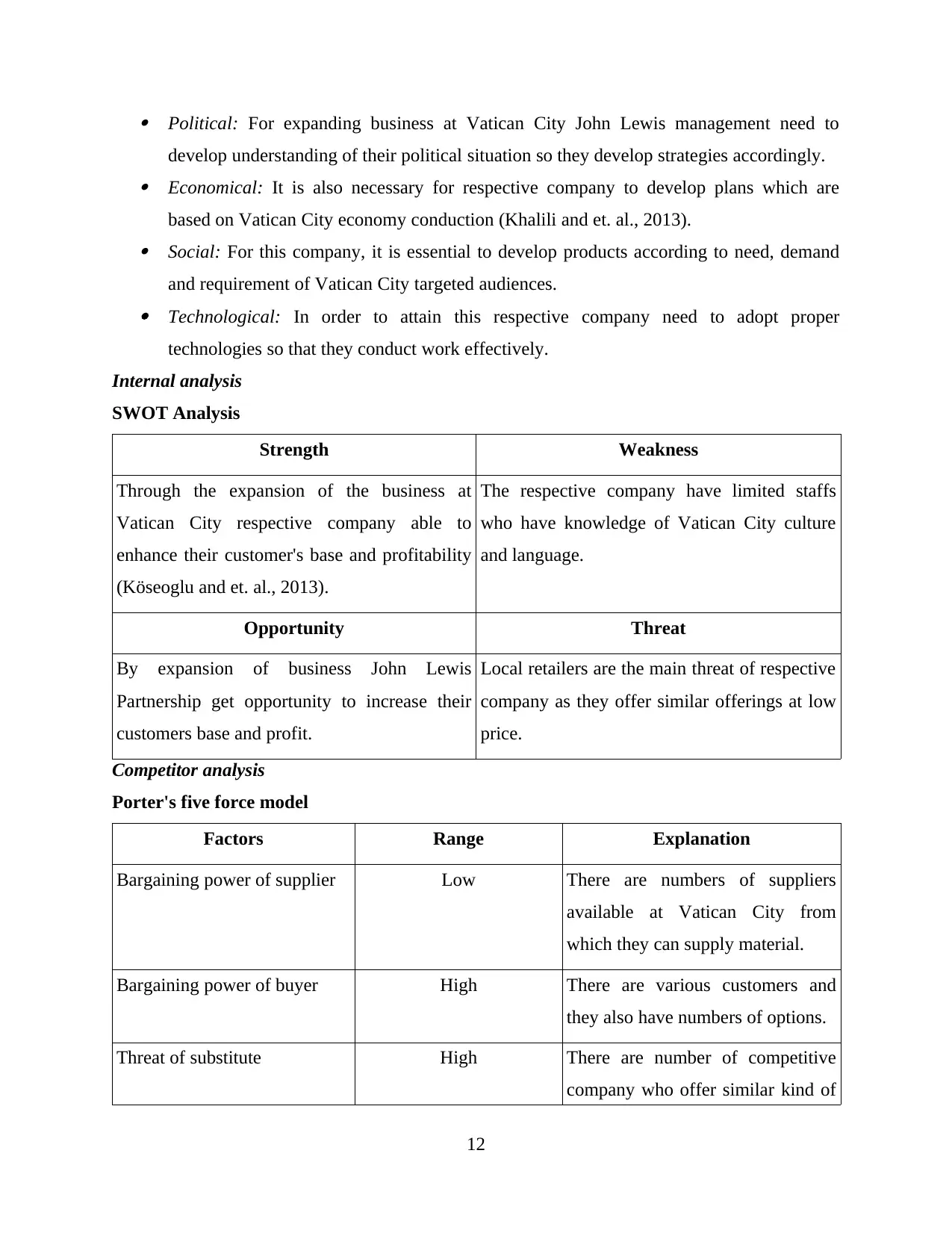
Political: For expanding business at Vatican City John Lewis management need to
develop understanding of their political situation so they develop strategies accordingly. Economical: It is also necessary for respective company to develop plans which are
based on Vatican City economy conduction (Khalili and et. al., 2013). Social: For this company, it is essential to develop products according to need, demand
and requirement of Vatican City targeted audiences. Technological: In order to attain this respective company need to adopt proper
technologies so that they conduct work effectively.
Internal analysis
SWOT Analysis
Strength Weakness
Through the expansion of the business at
Vatican City respective company able to
enhance their customer's base and profitability
(Köseoglu and et. al., 2013).
The respective company have limited staffs
who have knowledge of Vatican City culture
and language.
Opportunity Threat
By expansion of business John Lewis
Partnership get opportunity to increase their
customers base and profit.
Local retailers are the main threat of respective
company as they offer similar offerings at low
price.
Competitor analysis
Porter's five force model
Factors Range Explanation
Bargaining power of supplier Low There are numbers of suppliers
available at Vatican City from
which they can supply material.
Bargaining power of buyer High There are various customers and
they also have numbers of options.
Threat of substitute High There are number of competitive
company who offer similar kind of
12
develop understanding of their political situation so they develop strategies accordingly. Economical: It is also necessary for respective company to develop plans which are
based on Vatican City economy conduction (Khalili and et. al., 2013). Social: For this company, it is essential to develop products according to need, demand
and requirement of Vatican City targeted audiences. Technological: In order to attain this respective company need to adopt proper
technologies so that they conduct work effectively.
Internal analysis
SWOT Analysis
Strength Weakness
Through the expansion of the business at
Vatican City respective company able to
enhance their customer's base and profitability
(Köseoglu and et. al., 2013).
The respective company have limited staffs
who have knowledge of Vatican City culture
and language.
Opportunity Threat
By expansion of business John Lewis
Partnership get opportunity to increase their
customers base and profit.
Local retailers are the main threat of respective
company as they offer similar offerings at low
price.
Competitor analysis
Porter's five force model
Factors Range Explanation
Bargaining power of supplier Low There are numbers of suppliers
available at Vatican City from
which they can supply material.
Bargaining power of buyer High There are various customers and
they also have numbers of options.
Threat of substitute High There are number of competitive
company who offer similar kind of
12
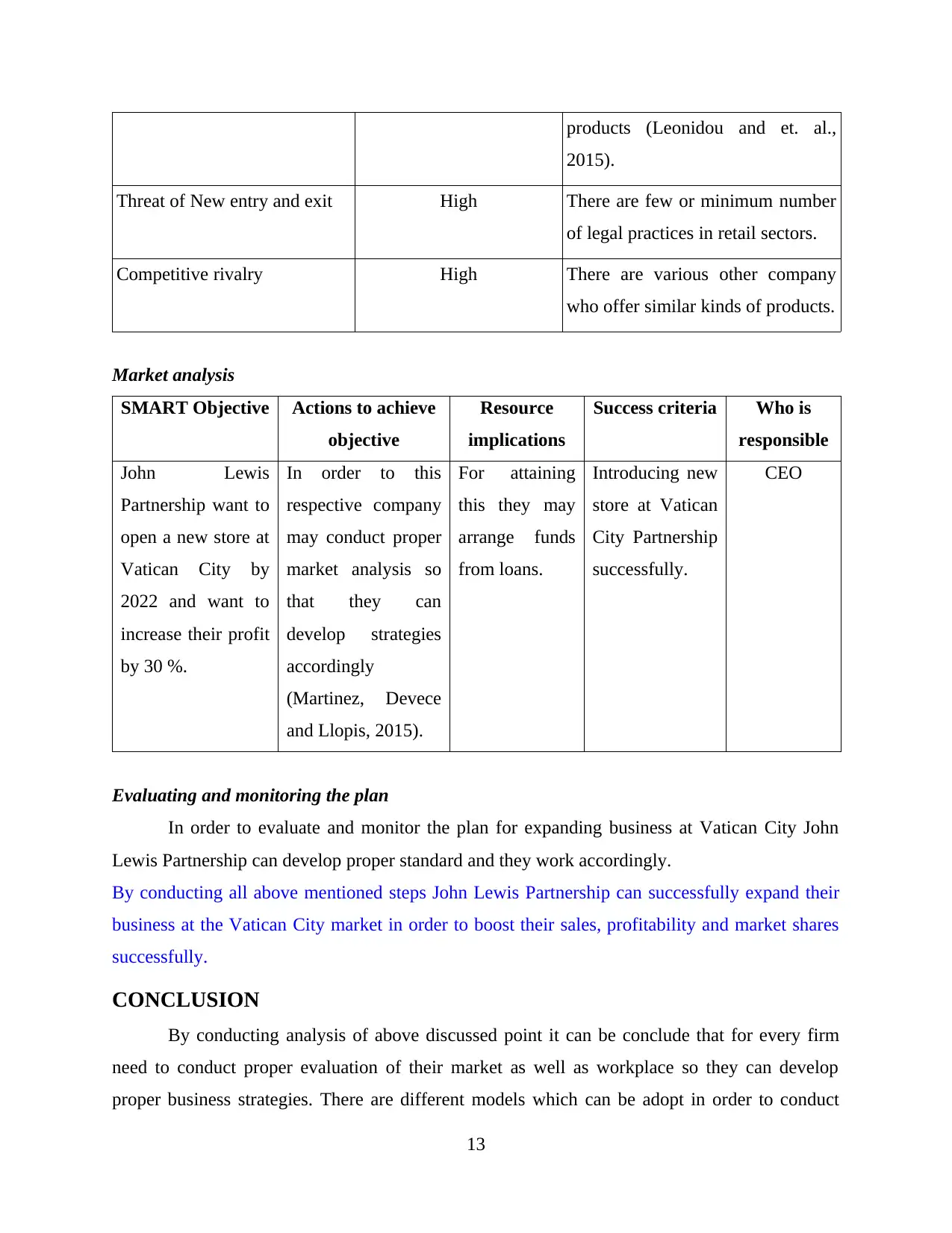
products (Leonidou and et. al.,
2015).
Threat of New entry and exit High There are few or minimum number
of legal practices in retail sectors.
Competitive rivalry High There are various other company
who offer similar kinds of products.
Market analysis
SMART Objective Actions to achieve
objective
Resource
implications
Success criteria Who is
responsible
John Lewis
Partnership want to
open a new store at
Vatican City by
2022 and want to
increase their profit
by 30 %.
In order to this
respective company
may conduct proper
market analysis so
that they can
develop strategies
accordingly
(Martinez, Devece
and Llopis, 2015).
For attaining
this they may
arrange funds
from loans.
Introducing new
store at Vatican
City Partnership
successfully.
CEO
Evaluating and monitoring the plan
In order to evaluate and monitor the plan for expanding business at Vatican City John
Lewis Partnership can develop proper standard and they work accordingly.
By conducting all above mentioned steps John Lewis Partnership can successfully expand their
business at the Vatican City market in order to boost their sales, profitability and market shares
successfully.
CONCLUSION
By conducting analysis of above discussed point it can be conclude that for every firm
need to conduct proper evaluation of their market as well as workplace so they can develop
proper business strategies. There are different models which can be adopt in order to conduct
13
2015).
Threat of New entry and exit High There are few or minimum number
of legal practices in retail sectors.
Competitive rivalry High There are various other company
who offer similar kinds of products.
Market analysis
SMART Objective Actions to achieve
objective
Resource
implications
Success criteria Who is
responsible
John Lewis
Partnership want to
open a new store at
Vatican City by
2022 and want to
increase their profit
by 30 %.
In order to this
respective company
may conduct proper
market analysis so
that they can
develop strategies
accordingly
(Martinez, Devece
and Llopis, 2015).
For attaining
this they may
arrange funds
from loans.
Introducing new
store at Vatican
City Partnership
successfully.
CEO
Evaluating and monitoring the plan
In order to evaluate and monitor the plan for expanding business at Vatican City John
Lewis Partnership can develop proper standard and they work accordingly.
By conducting all above mentioned steps John Lewis Partnership can successfully expand their
business at the Vatican City market in order to boost their sales, profitability and market shares
successfully.
CONCLUSION
By conducting analysis of above discussed point it can be conclude that for every firm
need to conduct proper evaluation of their market as well as workplace so they can develop
proper business strategies. There are different models which can be adopt in order to conduct
13
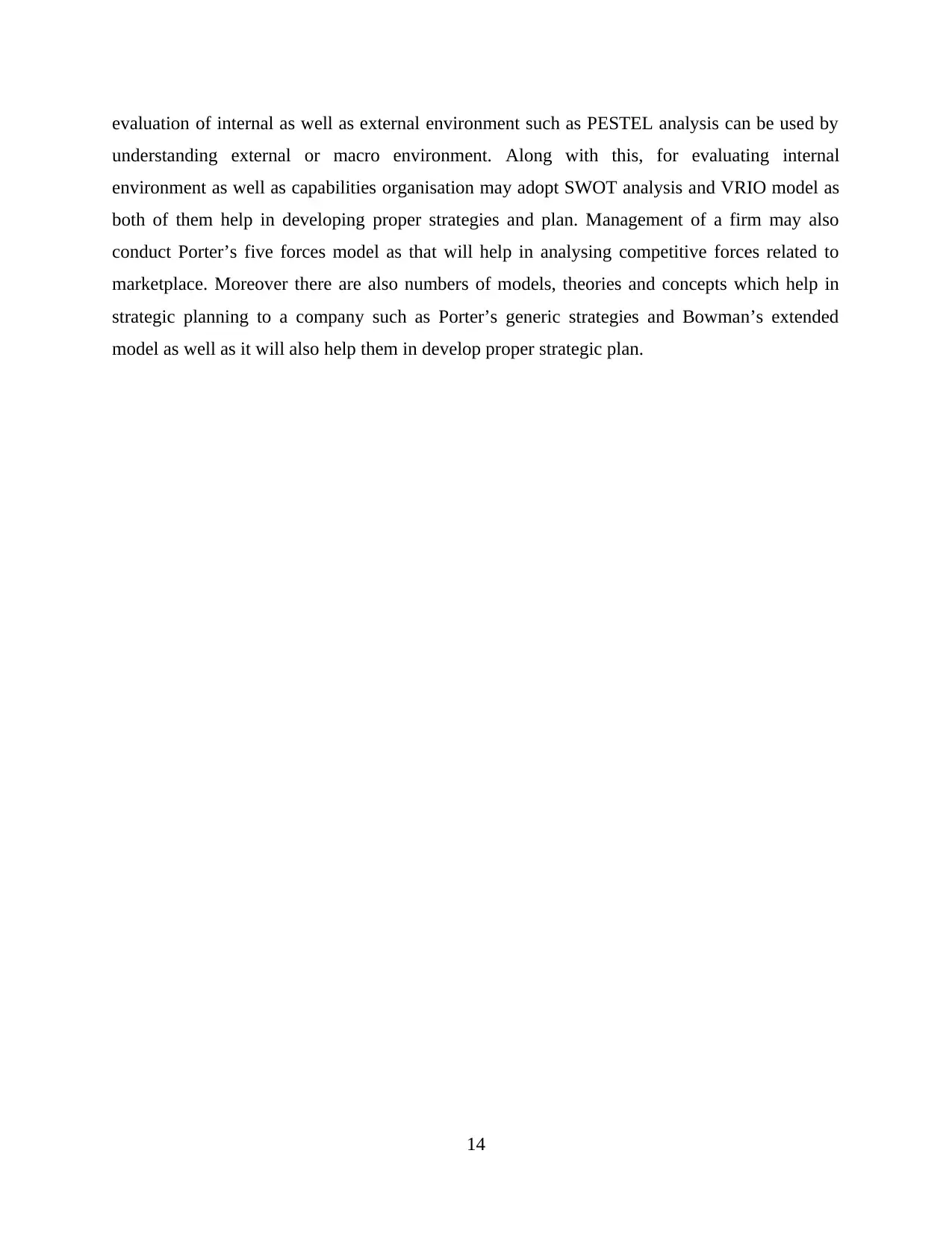
evaluation of internal as well as external environment such as PESTEL analysis can be used by
understanding external or macro environment. Along with this, for evaluating internal
environment as well as capabilities organisation may adopt SWOT analysis and VRIO model as
both of them help in developing proper strategies and plan. Management of a firm may also
conduct Porter’s five forces model as that will help in analysing competitive forces related to
marketplace. Moreover there are also numbers of models, theories and concepts which help in
strategic planning to a company such as Porter’s generic strategies and Bowman’s extended
model as well as it will also help them in develop proper strategic plan.
14
understanding external or macro environment. Along with this, for evaluating internal
environment as well as capabilities organisation may adopt SWOT analysis and VRIO model as
both of them help in developing proper strategies and plan. Management of a firm may also
conduct Porter’s five forces model as that will help in analysing competitive forces related to
marketplace. Moreover there are also numbers of models, theories and concepts which help in
strategic planning to a company such as Porter’s generic strategies and Bowman’s extended
model as well as it will also help them in develop proper strategic plan.
14
Secure Best Marks with AI Grader
Need help grading? Try our AI Grader for instant feedback on your assignments.
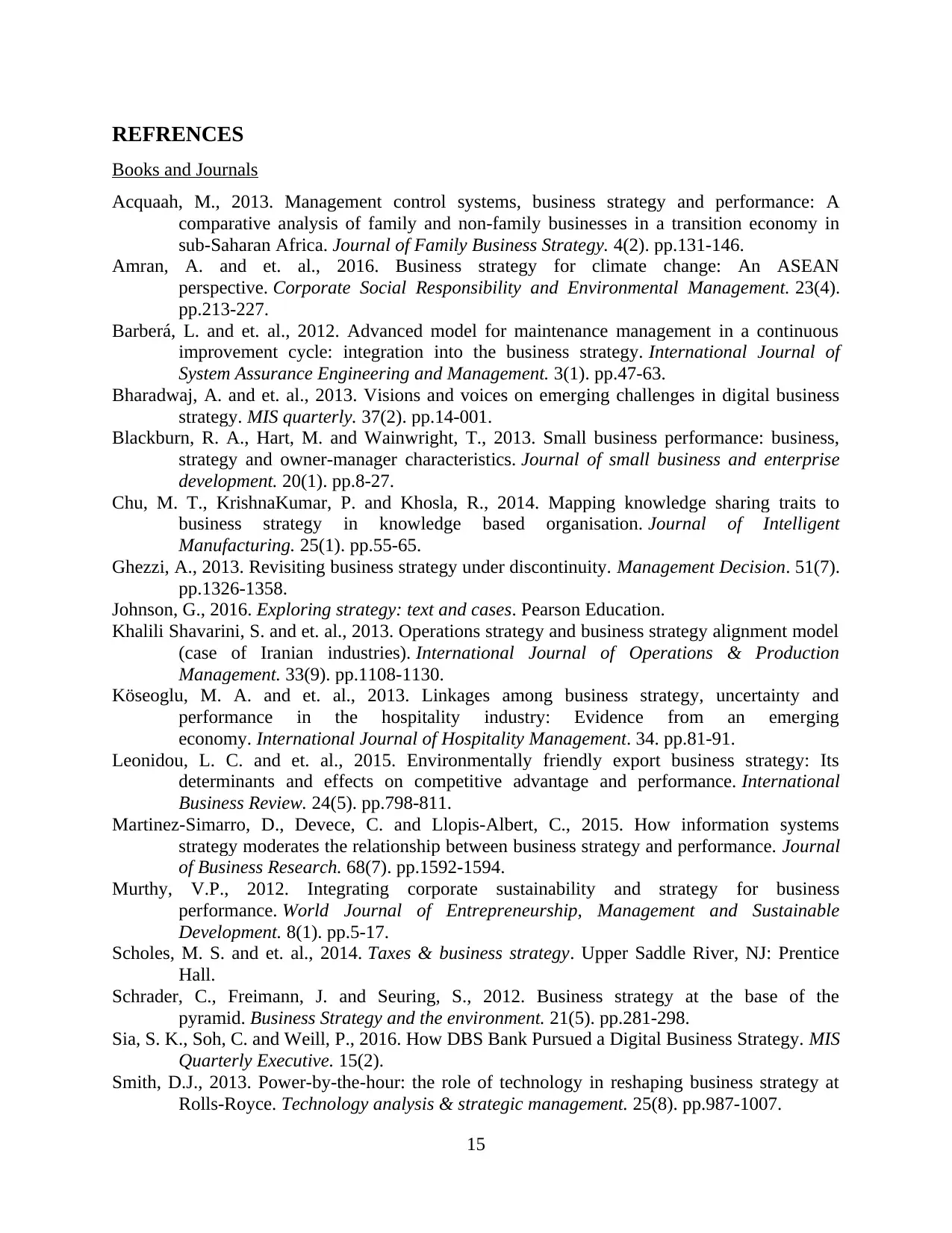
REFRENCES
Books and Journals
Acquaah, M., 2013. Management control systems, business strategy and performance: A
comparative analysis of family and non-family businesses in a transition economy in
sub-Saharan Africa. Journal of Family Business Strategy. 4(2). pp.131-146.
Amran, A. and et. al., 2016. Business strategy for climate change: An ASEAN
perspective. Corporate Social Responsibility and Environmental Management. 23(4).
pp.213-227.
Barberá, L. and et. al., 2012. Advanced model for maintenance management in a continuous
improvement cycle: integration into the business strategy. International Journal of
System Assurance Engineering and Management. 3(1). pp.47-63.
Bharadwaj, A. and et. al., 2013. Visions and voices on emerging challenges in digital business
strategy. MIS quarterly. 37(2). pp.14-001.
Blackburn, R. A., Hart, M. and Wainwright, T., 2013. Small business performance: business,
strategy and owner-manager characteristics. Journal of small business and enterprise
development. 20(1). pp.8-27.
Chu, M. T., KrishnaKumar, P. and Khosla, R., 2014. Mapping knowledge sharing traits to
business strategy in knowledge based organisation. Journal of Intelligent
Manufacturing. 25(1). pp.55-65.
Ghezzi, A., 2013. Revisiting business strategy under discontinuity. Management Decision. 51(7).
pp.1326-1358.
Johnson, G., 2016. Exploring strategy: text and cases. Pearson Education.
Khalili Shavarini, S. and et. al., 2013. Operations strategy and business strategy alignment model
(case of Iranian industries). International Journal of Operations & Production
Management. 33(9). pp.1108-1130.
Köseoglu, M. A. and et. al., 2013. Linkages among business strategy, uncertainty and
performance in the hospitality industry: Evidence from an emerging
economy. International Journal of Hospitality Management. 34. pp.81-91.
Leonidou, L. C. and et. al., 2015. Environmentally friendly export business strategy: Its
determinants and effects on competitive advantage and performance. International
Business Review. 24(5). pp.798-811.
Martinez-Simarro, D., Devece, C. and Llopis-Albert, C., 2015. How information systems
strategy moderates the relationship between business strategy and performance. Journal
of Business Research. 68(7). pp.1592-1594.
Murthy, V.P., 2012. Integrating corporate sustainability and strategy for business
performance. World Journal of Entrepreneurship, Management and Sustainable
Development. 8(1). pp.5-17.
Scholes, M. S. and et. al., 2014. Taxes & business strategy. Upper Saddle River, NJ: Prentice
Hall.
Schrader, C., Freimann, J. and Seuring, S., 2012. Business strategy at the base of the
pyramid. Business Strategy and the environment. 21(5). pp.281-298.
Sia, S. K., Soh, C. and Weill, P., 2016. How DBS Bank Pursued a Digital Business Strategy. MIS
Quarterly Executive. 15(2).
Smith, D.J., 2013. Power-by-the-hour: the role of technology in reshaping business strategy at
Rolls-Royce. Technology analysis & strategic management. 25(8). pp.987-1007.
15
Books and Journals
Acquaah, M., 2013. Management control systems, business strategy and performance: A
comparative analysis of family and non-family businesses in a transition economy in
sub-Saharan Africa. Journal of Family Business Strategy. 4(2). pp.131-146.
Amran, A. and et. al., 2016. Business strategy for climate change: An ASEAN
perspective. Corporate Social Responsibility and Environmental Management. 23(4).
pp.213-227.
Barberá, L. and et. al., 2012. Advanced model for maintenance management in a continuous
improvement cycle: integration into the business strategy. International Journal of
System Assurance Engineering and Management. 3(1). pp.47-63.
Bharadwaj, A. and et. al., 2013. Visions and voices on emerging challenges in digital business
strategy. MIS quarterly. 37(2). pp.14-001.
Blackburn, R. A., Hart, M. and Wainwright, T., 2013. Small business performance: business,
strategy and owner-manager characteristics. Journal of small business and enterprise
development. 20(1). pp.8-27.
Chu, M. T., KrishnaKumar, P. and Khosla, R., 2014. Mapping knowledge sharing traits to
business strategy in knowledge based organisation. Journal of Intelligent
Manufacturing. 25(1). pp.55-65.
Ghezzi, A., 2013. Revisiting business strategy under discontinuity. Management Decision. 51(7).
pp.1326-1358.
Johnson, G., 2016. Exploring strategy: text and cases. Pearson Education.
Khalili Shavarini, S. and et. al., 2013. Operations strategy and business strategy alignment model
(case of Iranian industries). International Journal of Operations & Production
Management. 33(9). pp.1108-1130.
Köseoglu, M. A. and et. al., 2013. Linkages among business strategy, uncertainty and
performance in the hospitality industry: Evidence from an emerging
economy. International Journal of Hospitality Management. 34. pp.81-91.
Leonidou, L. C. and et. al., 2015. Environmentally friendly export business strategy: Its
determinants and effects on competitive advantage and performance. International
Business Review. 24(5). pp.798-811.
Martinez-Simarro, D., Devece, C. and Llopis-Albert, C., 2015. How information systems
strategy moderates the relationship between business strategy and performance. Journal
of Business Research. 68(7). pp.1592-1594.
Murthy, V.P., 2012. Integrating corporate sustainability and strategy for business
performance. World Journal of Entrepreneurship, Management and Sustainable
Development. 8(1). pp.5-17.
Scholes, M. S. and et. al., 2014. Taxes & business strategy. Upper Saddle River, NJ: Prentice
Hall.
Schrader, C., Freimann, J. and Seuring, S., 2012. Business strategy at the base of the
pyramid. Business Strategy and the environment. 21(5). pp.281-298.
Sia, S. K., Soh, C. and Weill, P., 2016. How DBS Bank Pursued a Digital Business Strategy. MIS
Quarterly Executive. 15(2).
Smith, D.J., 2013. Power-by-the-hour: the role of technology in reshaping business strategy at
Rolls-Royce. Technology analysis & strategic management. 25(8). pp.987-1007.
15
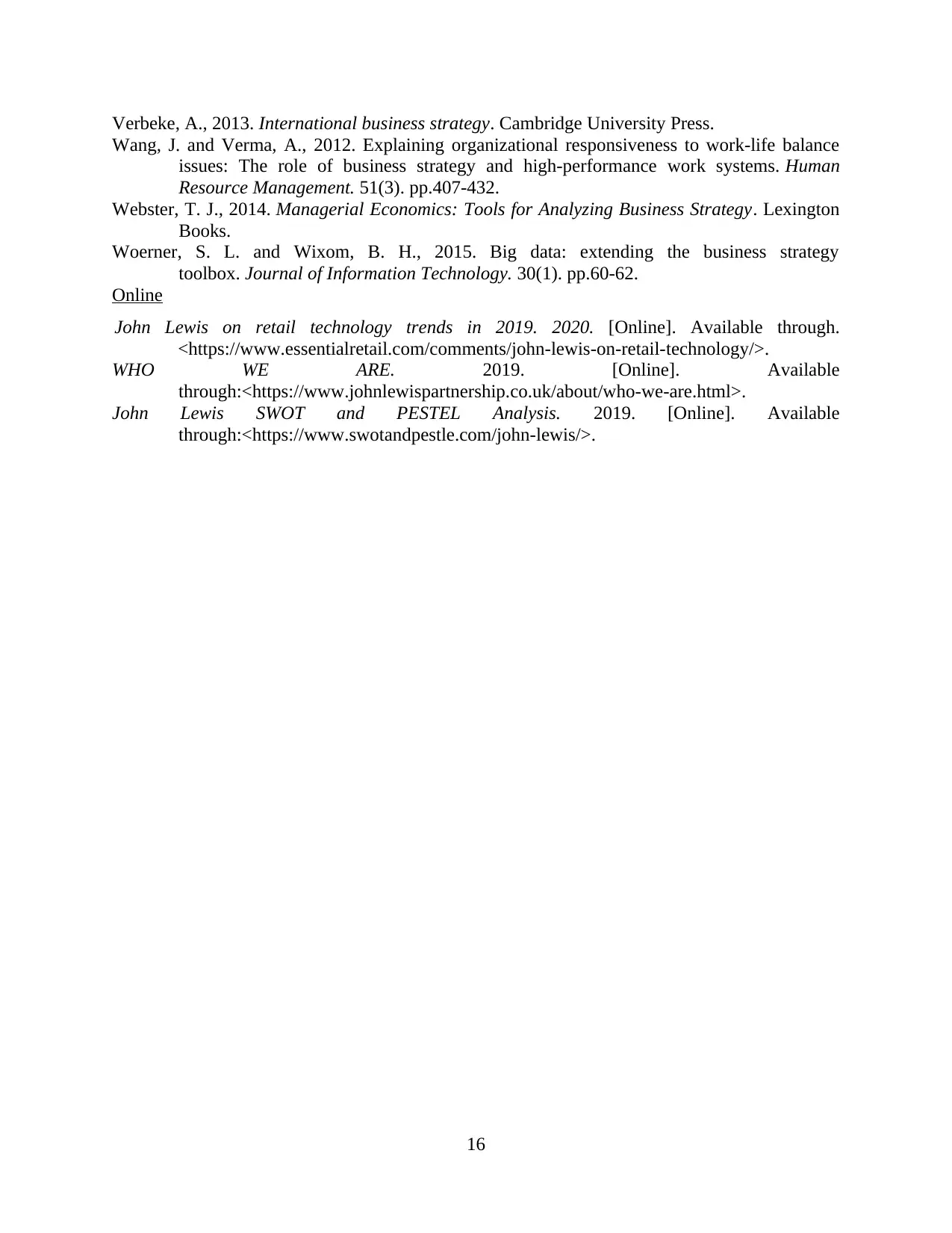
Verbeke, A., 2013. International business strategy. Cambridge University Press.
Wang, J. and Verma, A., 2012. Explaining organizational responsiveness to work‐life balance
issues: The role of business strategy and high‐performance work systems. Human
Resource Management. 51(3). pp.407-432.
Webster, T. J., 2014. Managerial Economics: Tools for Analyzing Business Strategy. Lexington
Books.
Woerner, S. L. and Wixom, B. H., 2015. Big data: extending the business strategy
toolbox. Journal of Information Technology. 30(1). pp.60-62.
Online
John Lewis on retail technology trends in 2019. 2020. [Online]. Available through.
<https://www.essentialretail.com/comments/john-lewis-on-retail-technology/>.
WHO WE ARE. 2019. [Online]. Available
through:<https://www.johnlewispartnership.co.uk/about/who-we-are.html>.
John Lewis SWOT and PESTEL Analysis. 2019. [Online]. Available
through:<https://www.swotandpestle.com/john-lewis/>.
16
Wang, J. and Verma, A., 2012. Explaining organizational responsiveness to work‐life balance
issues: The role of business strategy and high‐performance work systems. Human
Resource Management. 51(3). pp.407-432.
Webster, T. J., 2014. Managerial Economics: Tools for Analyzing Business Strategy. Lexington
Books.
Woerner, S. L. and Wixom, B. H., 2015. Big data: extending the business strategy
toolbox. Journal of Information Technology. 30(1). pp.60-62.
Online
John Lewis on retail technology trends in 2019. 2020. [Online]. Available through.
<https://www.essentialretail.com/comments/john-lewis-on-retail-technology/>.
WHO WE ARE. 2019. [Online]. Available
through:<https://www.johnlewispartnership.co.uk/about/who-we-are.html>.
John Lewis SWOT and PESTEL Analysis. 2019. [Online]. Available
through:<https://www.swotandpestle.com/john-lewis/>.
16
1 out of 18
Related Documents
Your All-in-One AI-Powered Toolkit for Academic Success.
+13062052269
info@desklib.com
Available 24*7 on WhatsApp / Email
![[object Object]](/_next/static/media/star-bottom.7253800d.svg)
Unlock your academic potential
© 2024 | Zucol Services PVT LTD | All rights reserved.





